Psychedelic decriminalization prompts polarizing reactions P. 10

Volume LXVI, No. 1 • October 6, 2023 •
redwood bark.
Larkspur, CA
Illustration by Ava Stephens
Editors-in-Chief:
ColetteBoyden
KateDeForrest
JordanKimball
MatthewMarotto
StaffIllustrators:
LaurenOlsen
AvaStephens
BusinessManagers: GilLadetzky
SamSumski
MultimediaDesigners: JuliaDelsol
HaydenDonehower
DataAnalyst:
GabriellaRouas
SocialMediaManagers:
CamerynSmith
EmmaRosenberg
PodcastEditor:
EllaBuske
StaffPhotographers:
LaurenPoulin
HarrisonLapic
SpanishEditors:
AlanaLeifer
EmilyGarcia
Fall2023Roster/Positions RedwoodHighSchool
395DohertyDrive,Larkspur,CA94939 www redwoodbark org
CopyEditors: EllaErwig(HeadCopy)
MayaWinger(HeadCopy)

TaylorAllan
AlexArgov
CharlotteFishburne
MiaGinsburg
LiliHakimi
HannahHerbst
NinaHoward
TallulahKnillAllen
NadiaMassoumi
LarkinMoffett
AshlinQuach
BellaWagner
Reporters: ElakaiAnela
AvaCarlson
SeanCunneen
ZacharyDinowitz
MollyGallagher
MasonGarbo
MatthewKnauer
JayKnopping
LinneaKoblik
OwenMcDaniels
BowenRivera
MichaelSeton
TylerSofnas
HenrikVraanes
MaggieWalsh
OpinionEditors: SawyerBarta
NickHartung
FeatureEditors: EmilyBlock
EricaBlock
LifestylesEditors: KateHarrison
AanikaSawhney
SportsEditors: CharlotteLacy
MaysonWeingart
SportsEditor-on-Call:
SydneyJohnson
NewsEditors: LeinaKhan
LucyWong
NewsEditor-on-Call: ElsaBlock
ReviewEditors: TessaDelay
BeckettTudor
WebDesigners: EmilyHitchcock
AnnaYoungs
VideoEditor: WillParsons
Catch tickets today to see ‘Peter and the Starcatcher’
By Taylor Allan
On Wednesday, Oct. 4, Redwood’s rendition of “Peter and the Starcatcher,” will open in the Black Box Theater. The play is a prequel to the famous “Peter Pan” fairytale. The cast, spanning across all four grade levels, rehearsed for over a month to open the curtains with a bang.
Set on two ships departing from Victorian England, three young orphans encounter a witty, bright girl named Molly Aster, the daughter of an English lord and minister to the queen. On their journey to the imaginary kingdom of Rundoon, the four children find themselves having to protect a valuable trunk of magical “starstuff” from nearby pirates, one of which is Black Stash, later known as Captain Hook.
Seasoned director of over 10 years, Elena Wright, loves the play’s mythical plot and the creativity that brought it to life.
“What’s great about [the play], is that it’s really fast-moving, the language is pretty simple and super fun,” Wright said.
“[The play] is like a love letter to theater in many [respects]. ... We have everyday objects that are used inventively to get the audience to use their imaginations.”
Another important aspect that gives this show its spark, is the role of the ensemble, the group of actors in the background of each scene. Senior Miles Doucette plays the role of Black Stash and has been in the drama program for almost four years.
“Some of the highlights have definitely been how ensemble-heavy this play is. It’s the kind of play where there isn’t really a backstage, everyone’s always on stage and in the scene.”
Senior, Calla Hollingsworth, with 10 years of acting experience, is playing the role of Peter, one of the lost boys, with whom she feels a personal connection.
“I played Peter Pan when I was 12 years old... so it’s kind of a full circle moment,” Hollingsworth said.
The play’s ability to show the importance of self discovery while preserving young innocence is something that Hollingsworth feels can evoke intense emotion in the audience and cast.
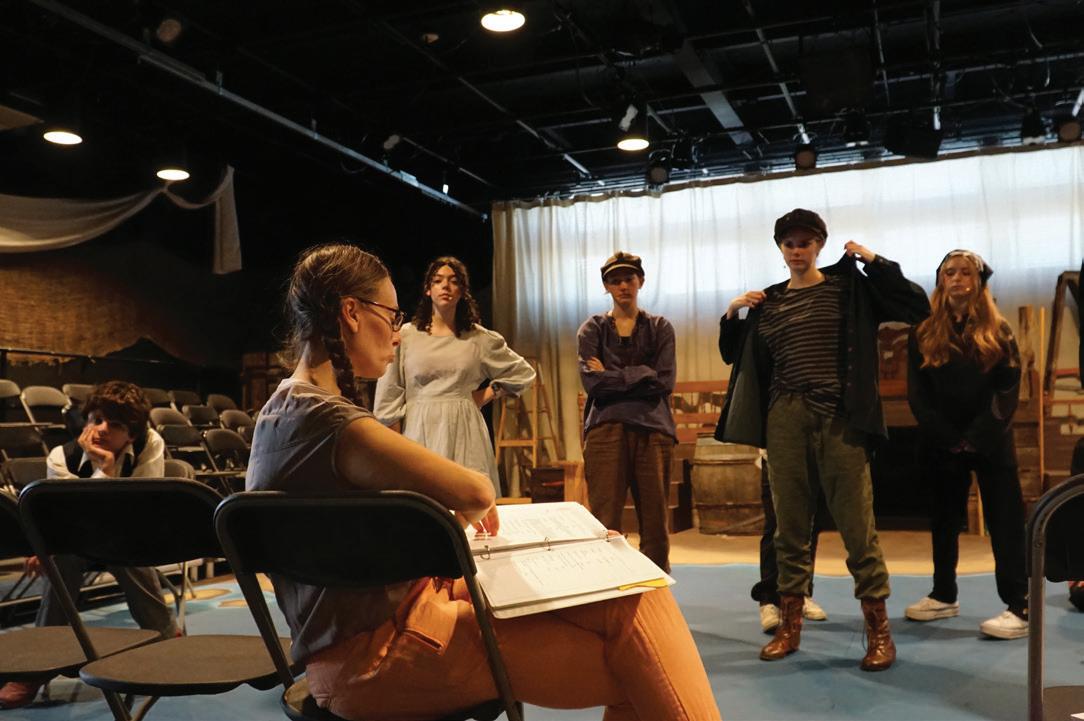
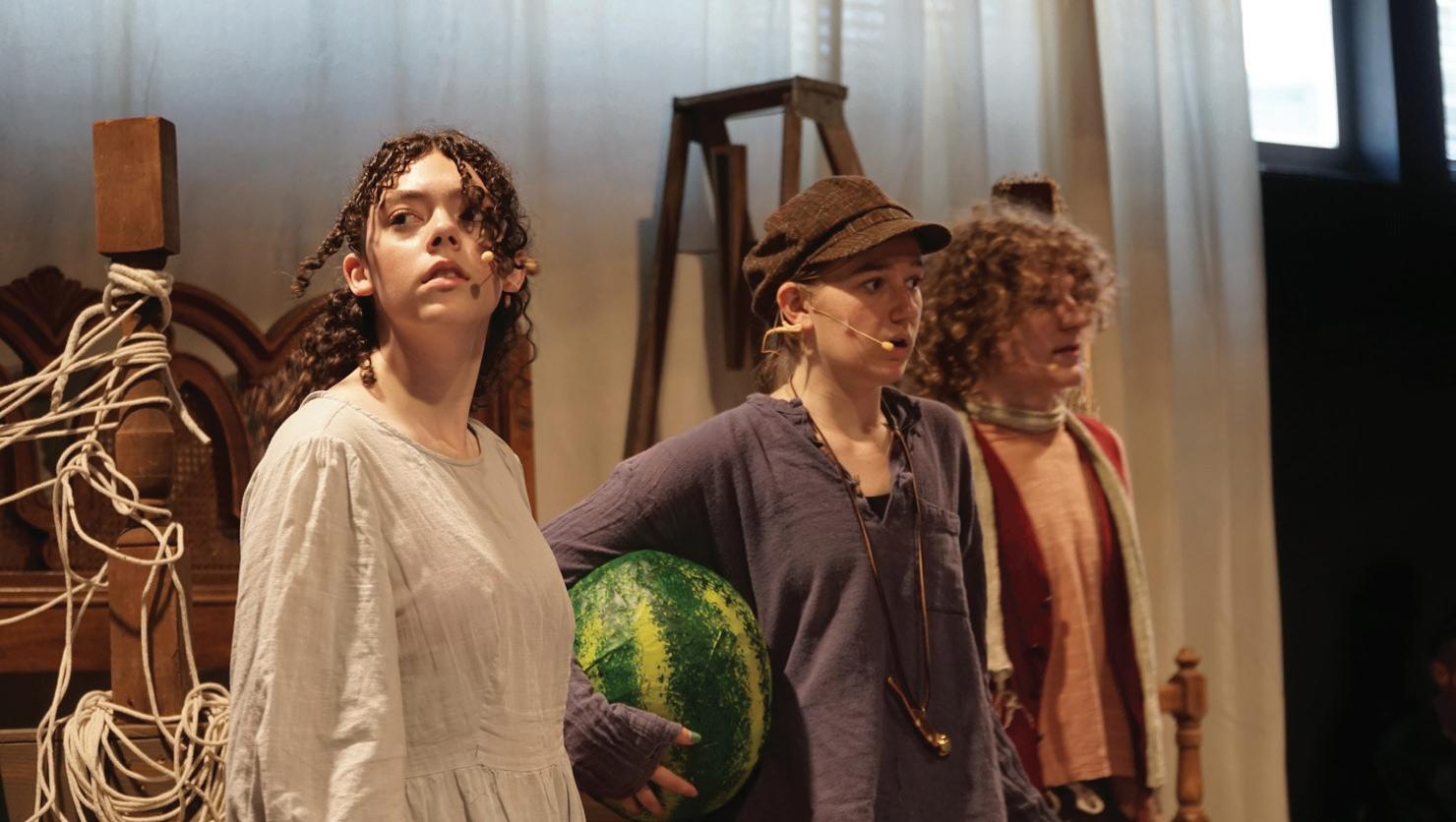
“The whole theme of never growing up is interesting because I am growing up and I’m graduating soon.
... A very challenging part of playing Peter is letting go of [my] desire to leave because I am ready to leave, but Peter wants to stay a boy,” Hollingsworth said.
Wright believes
these moving but lighthearted themes make it an ideal show for high school performers.
“[Peter and the Starcatcher] is one of the most popular plays done in high schools because its got a big cast, there is music and there is dance. And it’s all about learning how to do theater,” Wright said.
There are a great number of learning experiences for the actors participating in the show, one of which is stage combat –an important skill for a performer.
“We’re doing Quarterstaff fighting, where you practice hitting each other with sticks, without [actually] hitting each other,” Hollingsworth said.

Ever since the pandemic, the drama department struggled to reintegrate live music into their shows, but this production has a live piano player. Even though “Peter and the Starcatcher” is not technically a musical, there are a few musical numbers. For the set itself, the department brought in outside talent.
“We have a wonderful artist named Huda-Al-Jamal, who works at Archie Williams, and [has been] designing all of the set, costumes, props – almost everything,” Wright said.
The cast will be carrying out a total of five shows on Oct. 4 through 7 all starting at 7 p.m., and a Saturday matinee on Oct. 7 at 2 p.m.
Doucette expects that the audience will be able to appreciate the truly imaginative and colorful nature of the show.
“I think the draw is it’s a wacky play. The phrasing of some of the lines has been interesting because the words get pretty whimsical at times,” Doucette said. “[The play] is such a contrast to the book because the book is dark and spooky, but the play is like a complete township. It’s such a funny and silly show.”
Tickets sold in front of the Black Box Theater are $5 for students and $10 for adults.
tallan@redwoodbark.org
Beloved Ohana Açaí Cafe forced to close its doors
By Maggie Walsh
Redwood açaí lovers are saying a tearful goodbye to their go-to spot for healthy and refreshing bowls. Ohana Açaí Cafe thrived for over a decade and now closes its doors forever. Ohana is a vibrant and beloved café that introduced the community to the wonders of exotic superfood and is a cherished part of Marin County’s culinary landscape, leaving locals with fond memories and a craving for a taste of their signature açaí bowls.
Ohana owners Todd and April Donaldson are a married couple from Fairfax, who not only run Ohana but also Mana Bowls, another açai café located in downtown Fairfax. They opened Mana Bowls 12 years ago, which has thrived on serving local students and families looking.

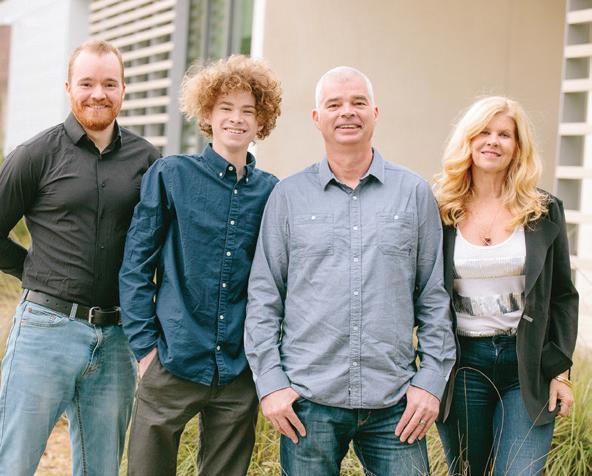
“We were the first to do açaí in Marin County and we fell in love with it. We decided to [open] another [location] and we picked [Larkspur]. It was six years of a steady rise, and we did really well during the pandemic, ironically. ... It was unfortunate how it ended,” Todd said.
April Donaldson recounts the extensive dedication of time, energy and financial resources it took to open Ohana.
“When we moved in, it was just two blank walls. There was nothing there. It



had been a pop-up, like an athletic store. We built the whole thing. Every single detail in that cafe we put in,” April said.
The Donaldson’s were caught off guard when they received an unexpected letter announcing the cafe’s closure.
“Our landlord refused to renew our lease for no reason whatsoever. We offered more rent, we offered double the rent. We offered everything under the sun because we wanted to stay so badly. It was just
crushing. We thought maybe he would realize that he was making a mistake for the shopping center,” April said.
Within only a few weeks, they were expected to close their storefront and be ready to depart.
“Our daughter graduated from Archie Williams three weeks after we opened the letter. They wanted us out on her graduation day. They said, ‘We couldn’t care less. Get out on that day.’ We ended up finding out

that the letter was delivered incorrectly. They hadn’t done the proper procedure. They gave us another week, ” April said.


Todd tried to share his experience with the landlord as best he could.
“He never wanted to meet, that’s the thing. And unfortunately, it impacted the shopping center and community. ... We spent a lot of money building that place and he took it away from us. He had every legal right to, but he doesn’t have any integrity,” Todd said.
For loyal customer and sophomore Mimi Wood, Ohana was her go-to lunch spot. Now, she is looking for new places.
“I loved Ohana. It was an amazing place to go for lunch and the only smoothie bowl place I really liked,” Wood said.
The owners promoted Ohana and Mana bowls to be as successful as possible. They became beloved cafes for students from both Archie Williams and Redwood.
“Clean organic food. My daughter was in high school and growing up in this county, I liked giving back,” Todd said.


The owner of the commercial property was contacted and declined to comment. For now, the Ohana owners are hoping the best for Mana Bowls while trying to figure out more opportunities to open another spot for açaí throughout Marin.
mwalsh@redwoodbark.org
bark redwood redwood high school ● 395 doherty dr., larkspur, ca 94939 ● volume LXVI, no. 1 ● October 6, 2023 ● www.redwoodbark.org . 10 The Psychedelic Divide Autumn Adventures Sports Spotlight Volume LXVI, No. 1 • October 6, 2023 • Larkspur, CA 14 16
STANDING IN FRONT of the old Ohana sign, owners April and Todd Donaldson prepare to continue business at a second location in Fairfax.
REYES LAKE, ALLY Woodru and Alexander Berkowitz react to castmates’ lines.
DAYS BEFORE OPENING night, Elena Wright directs the cast.
Photo by Taylor Allan
Photo by Taylor Allan
Photo by Maggie Walsh
Photo Survey
“My favorite fall-related memory is getting to dress up for Halloween with my friends.”



“How easy school is during that time of year and getting to have lots of free time to do whatever I want.”


“The first time I visited my sister in college. I helped her move and went to a Halloween frat party.”

SAT goes digital: A new era of standardized testing
By Molly Gallagher
For all of the upcoming test takers out there, listen up; the SAT will be completely digital in the spring of 2024 along with the PSAT, which will be administered digitally this fall on Oct. 14. This update will have the largest impact on the classes of ‘24 and ‘25 as there have been notable changes

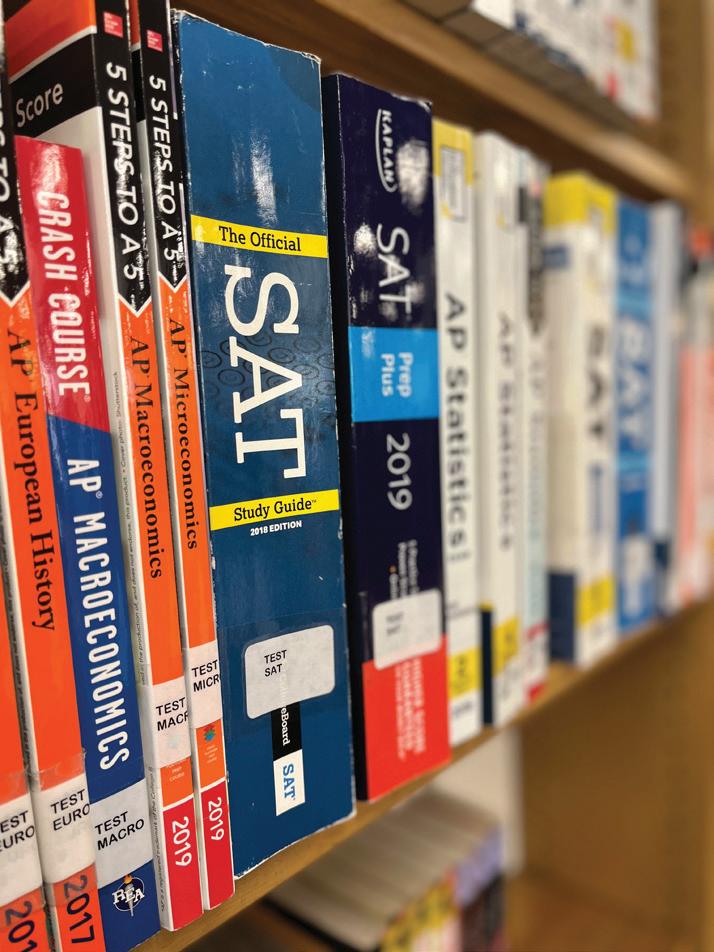
made to the test for their year. The reading section is now more concise, questions are more direct and the most significant change is the test’s adaptability. Essentially, the test will adjust the difficulty of questions depending on the student’s performance on previous questions, tailoring the test to the skill level of the student.
Due to this change, students may have to alter their original plans and studying habits in order to adapt to the digital SAT. One student that isn’t particularly happy with this new computerization of the SAT is junior Mary Coleman. Coleman plans to take the SAT and has put in a lot of study hours, but with the change to digital, her work might have been for nothing.
“If I take the paper SAT, I have to take it this semester, which is a lot of stress. If I wait for the digital SAT, a lot of work [will] be undone and I’m going to have to study differently all over again,” Coleman said.
A common worry shared among students is how the adaptive nature of the SAT will affect their scores and the way
colleges will perceive them.
On the other hand, students like junior Avery Tucker prefer the SAT going digital, since the reading sections are easier to comprehend. Tucker has taken both a paper and digital version of the PSAT.

“I thought that the reading and writing sections were much easier on the digital one because of the shorter paragraphs,” Tucker said.
However, there are still students who remain indifferent to the shift towards digital SAT testing. To many, it’s still the same test, so therefore being online or on paper won’t make a difference to them. Junior Clark McGee had similar thoughts to this line of thinking.
“The test being digital doesn’t change anything. I think it will still be the same exact thing [as before],” McGee said.





If you plan to take the digital PSAT this fall on Oct. 14, visit the Redwood website and complete your registration today.


msgallagher@redwoodbark.org
New vocational school expands opportunities for students
By Michael Seton
In early September, construction began on a new vocational school on the Terra Linda High School campus. This outdoor covered classroom and related staffing, equipment and class development is funded by $1.6 million in private donations from 100 different contributors. Students at Redwood and other Marin County high schools can access this educational center via transportation vans for classes after school, on evenings and weekends.
The building will take several months to complete. Once opened, the Marin County Office of Education plans to offer classes in electrical work, plumbing, welding, auto repair, building ventilation systems, health sciences, medical technology and education. This will be a vast expansion of Redwood’s current Career Technical Education offerings, which are limited to engineering, architecture, computer
programming and design, digital design and communication, accounting and woodshop.
Engineering Projects teacher Tom Eller suspects budget issues are limiting Redwood’s ability to meet current demand for more vocational classes.
“Engineering Projects classes fill up every year. Last year I had 25 Redwood students. It was full by September and it didn’t start until January,” Eller said. “There’s 10 students that have already signed up this year as well. The interest is there.”
Senior Giovana Goncalves mentioned that both her Honors Architecture and Engineering Projects classes are full this year, noting these classes give students lifelong skills.

“When I walked into the ROP [Regional Occupation Program] class, I didn’t know how to turn on a drill or to use a skilsaw,” said Goncalves. “Now I’ve built two sheds. It’s definitely a place where you learn skills for life.”
Marin parents, educators and students share a longtime concern about the conspicuous absence of vocational education programs in its high schools. This shortcoming was the focus of a Marin County Civil Grand Jury report in 2019.

The Grand Jury found that approximately 60 percent of Marin high school graduates obtain little or no formal education beyond their high school degree.



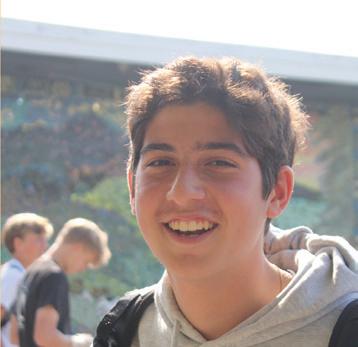

Their data showed that while 77 percent of Marin County high school graduates go on to college, community college or a certificate program, only half of those students complete those programs.
The lack of vocational education opportunities raises questions about the county’s ability to prepare its youth for the future workforce. One of the primary reasons for the lack of vocational training programs is the county’s historical emphasis on college preparatory curriculum.
“This [college] focus does not serve the interests of a substantial number of students who will complete their formal education with graduation from high school or who will not ultimately attain a college degree,” the Grand Jury report states.

However, the Grand Jury also acknowledged that Marin does not have the facilities in place to train the significant cohort of students who will work in a trade.
Obstacles to addressing this problem include lack of physical resources and eliminating the stigma associated with vocational education. Funding is another significant hurdle, as these programs often require specialized equipment and instructors with industry experience.
To address these challenges, some Marin County residents formed grassroots organizations, such as the non-profit Shifting Gears USA, whose chairman, Ross resident Charles Goodman, helped organize the fundraising campaign for the new vocational school in Terra Linda.

Eller noticed a positive impact on his students from learning various trade skills.
“Their confidence level went up no matter what class they took,” Eller said. “They can do it and it’s great to see the confidence on their faces.”
mseton@redwoodbark.org
bark Page 2 • News October 6, 2023
COMMENCING IN SEPTEMBER, construction on the new vocational structure at Terra Linda High School will take several months to complete.
“Whatisyour favorite fall-related memory?”
ROWS OF SAT prep books sit in the Library for student use.
Photo by Leina Khan
“My favorite memory would have to be putting up fall and Halloween decorations with my family.”
Ashby Plexico Freshman Alex Fooman Sophomore Theo Timpson Junior Brit Norris Senior
If I take the paper SAT, I have to take it this semester. If I wait for the digital SAT, a lot of that work [will] be undone.
Mary Coleman, junior
Photo by Michael Seton
Photo by Michael Seton BUILDING ENGINEERING PROJECTS, students acquire lifelong skills.
SAG-AFTRA members demand compensation
Creative acting minds strike for change in the arts
By Larkin Moffett
“We’re all artists and we are all trying to make art, and the fact that people aren’t being paid fairly for things [makes] it hard, really hard to write and to act,” Calla Hollingsworth said, a senior drama student.
The Screen Actors Guild - American Federation of Television and Radio Artists (SAG-AFTRA) strike has been active since the night of July 14, 2023. SAGAFTRA is a union representing around 160,000 actors, announcers, recording artists, journalists and other media professionals led by their president, Fran Drescher. Since artificial intelligence (AI) has become a tool many industries rely on, the demand for workers to perform tasks has decreased, consequently reducing their pay. Nicole Cyrille, an actor with SAGAFTRA, the chair for Performers With Disabilities and serves as a member of the Negotiations Committee, noted SAGAFTRA’s demands against the use of AI.
“A huge [demand for SAG-AFTRA] is AI protection. [Corporations] believe that they should be able to scan us digitally [and] take our voiceprint scanner image. They think they [can] scan you one day and be able to use you for the rest of their lives. You don’t even own your own identities. They get to do that without paying you, without telling you [or] getting your approval and without telling the audience that this is happening,” Cyrille said.
Another issue is the current amount of pay itself. Out of the 160,000 members of SAG-AFTRA, only 13 percent make above $26,000 a year, which barely meets the minimum income threshold for households
seeking health insurance.
“Whenever we have a contract dispute, [the public] thinks we’re just whiny rich people. Now they’re seeing that most of us are blue-collar workers like everybody else. We’re struggling to pay rent in a one-
bedroom apartment,” Cyrille said.
The last time both writers and actors went on strike together was in 1960, battling for healthcare coverage within Hollywood and acting jobs.
“I think it’s definitely been a lesson
in business for everyone. This isn’t the first time [actors] have [struck], and it’s by no means going to be the last strike,” Hollingsworth said.
These strikes have been ongoing throughout the summer and many fans and non-SAG-AFTRA members have protested alongside them displaying their support. Junior Josie Smith attended a strike in New York City and felt moved by what she witnessed.

“[There] was a picket line and metal bars, and [there were] probably 25 people holding signs and chanting. A few other girls [and I] went in and got to [protest] with them,” Smith said. “It was inspiring how [the actors] were out there for hours, marching with their shirts and signs.”
While the guild is on strike, members are held accountable to only perform union-related work to the strike. The support from their fan bases never goes unnoticed and adds fuel to their fight.
“To see fans of one of the shows I’m on, fans from all over the world flew to Los Angeles to bring food to our picket line, [showed a] level of kindness and love that just warms your heart. … Right now, just keep being loud. Just keep tagging those studio heads and telling them to treat the writers and the actors with dignity and fairness [and] with a living wage. That is what we need. That is what we could use right now from you guys. We appreciate all that we’ve been seeing so far, we really do,” Cyrille said. As of press time, SAGAFTRA planned to meet Wednesday, Oct. 4 to begin negotiations.
COM offers ethnic studies course on Redwood’s campus
By Tessa DeLay
This fall, College of Marin (COM) is offering an ethnic studies course at Redwood, the first college class to ever be offered directly on campus grounds. This course, Intro to Ethnic Studies, takes place in room 705 from 2 to 5 p.m. on Wednesdays. Students were able to enroll through the COM website and could receive support from their school counselor, if needed. The course covers a variety of
topics, from multiculturalism to migration, while challenging students to develop critical thinking skills.
Senior Mila Mincy enrolled in the class in the hopes of broadening her perspective through the understanding other cultures.
“I want to enhance my cultural and societal awareness and sensitivity, which is really valuable in an increasingly diverse world,” Mincy said.
The course focuses on exploring different social concepts, as opposed to specific historical events. Through the use of case studies and historical current events, students develop a deeper understanding of what makes up social culture, the role ethnic groups play in society and the influence of power on social systems.
“My thinking has been challenged,” Mincy said. “I am not just reading from a textbook and reporting what I read. I am learning how to think between the lines.”
Professor Eddie Madril teaches American Indian studies at San Francisco State University and ethnic studies at COM. Madril fosters the development of critical thinking skills by encouraging students to consider questions about the context in which information is presented.
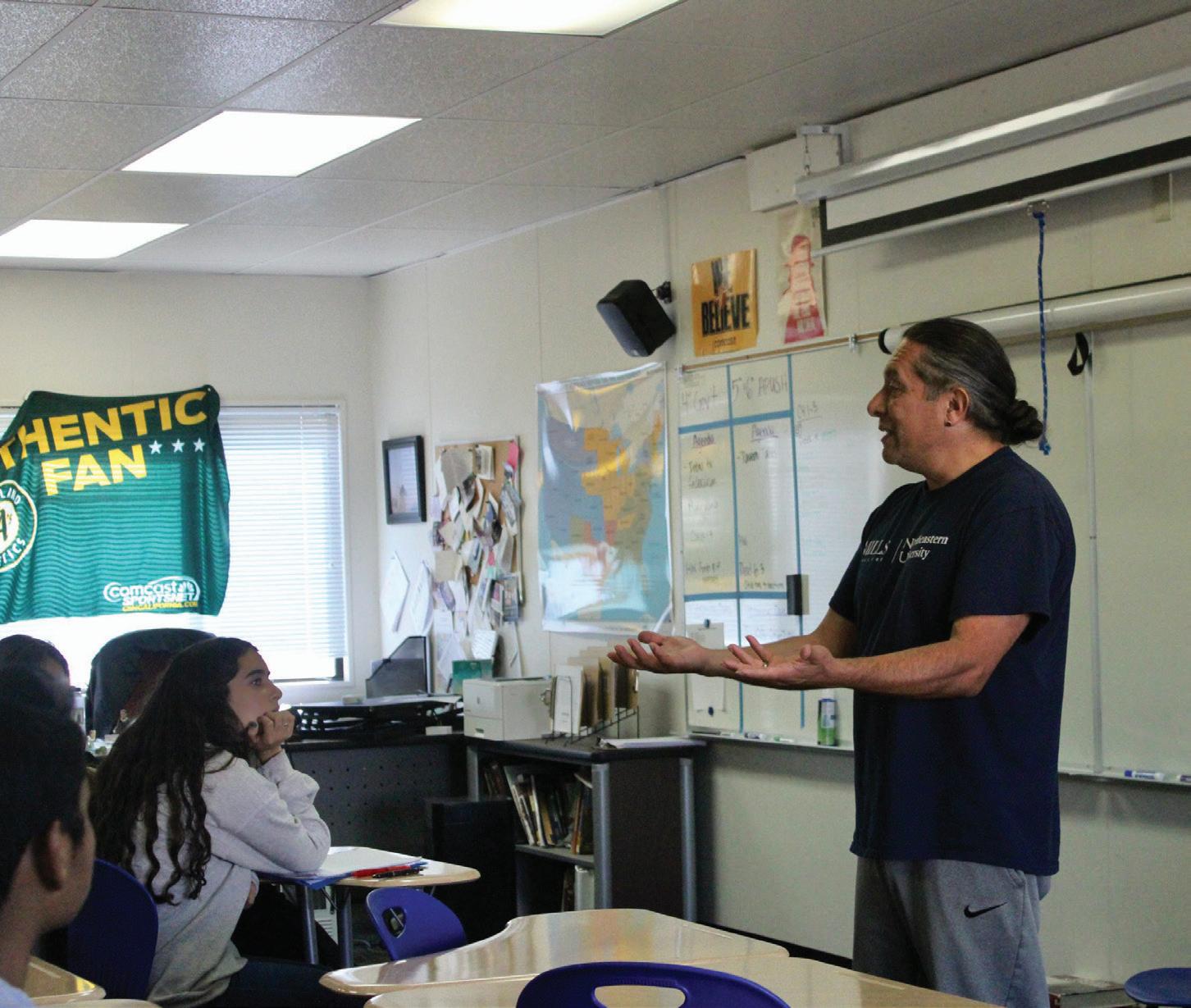
“In what ways do we look at things? In what ways can we analyze things? In what ways do we critique things? In what ways do we get information? Where is that information sourced from? What is the validity and credibility of that information source?” Madril said.
Students have the choice to enroll in the class and Madril expects them to engage in classroom discussions to enhance their learning.

“You have to contribute. If you are not contributing, there is no growth,” Madril said.
In addition to expanding their perspectives and knowledge through this class, students can also gain firsthand experience in a college course. College and Career Specialist Becky Bjursten emphasized the benefits of taking a college class, including the ability to earn college credit if students complete the course with a passing grade.
“To me, the fact that [this class] can give you college experience and can possibly take out one of your general
education requirements when you do go away to college, [means] there are only upsides to it as long as it seems like the right class for you,” Bjursten said.
By offering this course on campus, both COM and Redwood aspire to promote equity by expanding access to collegelevel classes to more students.
“Not everybody has transportation or maybe they have an afterschool job, or maybe they have some other responsibility that makes it harder for them to get to another campus after school, so bringing [COM’s] campus to [Redwood] gives this college opportunity to students right here,” Bjursten said.
bark www.redwoodbark.org Page 3 • News
If you are not contributing, there is no growth.
Eddie Madril, professor
STANDING WITH SAG-AFTRA, members commence their protest in the rain.
Photo courtesy of “SAG-AFTRA”
STANDING IN FRONT of the room, Professor Madril speaks to an Ethnic Studies class in the portable classrooms at Redwood.
Photo by Tessa DeLay
STUDENTS LISTEN AND take notes attentively as Professor Madril speaks to the class.
tdelay@redwoodbark.org
Photo by Tessa DeLay
lmoffett@redwoodbark.org
Shopping for stories: The currency of true happiness
 By Erica Block
By Erica Block
The 21st century is a consumer-driven experience, where material possessions and wealth take center stage. We are constantly bombarded by TV commercials, advertisements and social media that tell us to buy, buy, buy — insisting that buying that new t-shirt or fancy laptop will bring us joy. While we might receive feelings of excitement after a material purchase, is this sentiment long-lasting, or rather a fleeting feeling that tends to diminish as the goods we purchase become obsolete? The inescapable truth is, material goods, despite their glowing facade, cannot buy happiness. Rather, it's the experiences, the moments that build our character and fill us with memories, that deserve our loyal payment.
The happiness one may receive after purchasing a material good is shorter lasting than that of an experience. As a financial psychologist Dr. Brad Kolnz noted, material possessions can give a boost to one's enjoyment but the happiness is fleeting as your brain adjusts to the “new normal.” I think it's fair to say we have all felt the initial buyer’s high: the joy of knowing something

you desired is finally in your possession. However, this feeling ultimately fades. Does wearing those new converse you bought two months ago still make you as happy as when they were fresh and new?
I don't think so. Slowly, as your purchases wear and tear, and you become used to their presence,he happiness they once brought you disappears.
On the contrary, experiences become imprinted into our minds and can bring a smile thinking about them or sharing the memory with a friend. In fact, a new study published in the Journal of Experimental Social Psychology reaffirms the fact that our experiential purchases can bring us greater pleasure in terms of anticipation, remembrance and in-the-moment enjoyment. This is primarily because we talk more about our experimental purchases — and that in itself brings us more
joy. Some may believe that paying for a short-term experience is less valuable than, for instance, a tangible object like a couch that can last years. However, according to the Atlantic, most of us have a high “hedonic adaptation,” where we begin to lose appreciation for the things we are exposed to, such as that couch we’ve had for many years. In comparison, it's the fleetingness of experiences, the fact that they exist for a finite amount of time, that makes us savor and appreciate them more. Not only do experiences bring a more enduring sense of happiness, but they become a piece of our identity. Poet Heinrich Heine famously said, “Ask not what I have, but what I am.” Experiences define who we are. It is unquestionable that we are a compilation of all of our experiences: the people we meet, the things we hear and the stories we can tell. Even if an experience brings up negative emotions, we often find ways to bond with others over it, or at least get a good laugh thinking about it. All experiences build on to who we are — whether we simply enjoy it for what it is, or if it changes the way we see and feel about the world.
Whether it be physical or not, possessions, by nature, foster comparisons. There will always be someone with a better phone or a newer car. However, it has been found that while we may compare experiences, we don’t compare them to the same extent as we do our material goods. This discovery was made clear in a Harvard study where people were asked if they’d rather have a high salary that was lower than the
Being gifted is not a gift
By Maya
Rory Gilmore used to be my idol. As the main character in the show “Gilmore Girls,” she seemed to have it all: the grades, the praise, the confidence. Rory Gilmore was a “gifted kid.” From a young age, she was reading Dostoevsky and Tolstoy and everyone believed she was a genius. However, for anyone who has seen the show, they know about her downfall. This constant admiration and approval from adults may have been the reason why she burnt out later in life.
Believe it or not, Rory isn’t the only example of this. In fact, it’s so common that there’s a name for it: gifted kid syndrome. This term describes children who are labeled as “gifted” or “advanced” from a young age and placed into higherlevel classes than their peers or given extra assignments and work to challenge them. Despite these seemingly overwhelming benefits, this experience isn’t all it’s cracked up to be. As someone who was given extra work and reading to challenge myself in school, I know firsthand the downsides that come with being labeled as “gifted.” Not only does this isolate you from your peers, but it makes them
feel inferior, even if they are right where they need to be.
Additionally, many once-gifted children now suffer from various mental illnesses. According to clinical psychologist Elke Van Hoof, 87 percent of gifted adults are considered highly sensitive people. This means that they are deeply sensitive to emotional, physical and social situations, which in turn can lead to anxiety, depression and more.
Not only can this glorification of children’s abilities contribute to mental illness later in life, but the constant pressure to perform at a high level can make them feel the need to be perfect all the time. In the 2017-2018 California Healthy Kids Survey, 11th grade students at Redwood self-reported that 54
percent of them felt the pressure of high expectations in school from adults. This high-level pressure may lead to academic burnout, which is defined by the National Library of Medicine as, “the feeling of exhaustion resulting from a compulsion for study, pessimism toward the assignments, and feeling incompetent as a student.” When students feel too much pressure from people like parents and teachers, their motivation for schoolwork can deplete significantly.
This pressure is not always from parents or teachers – a lot of the time the stress and anxiety that students feel to succeed is internalized pressure. Some people see this pressure as beneficial to students; the much-needed motivation for the newest generation to stop scrolling and start focusing. However, this is only true to a certain extent.

It’s important to have motivation and drive
– after all, no one ever succeeded without such things. But there’s a fine line between
ones their peers received or a low salary that was higher than that of their peers. Responses showed that a lot of them weren’t sure. However, when they were asked the same question about the length of their holidays, most people chose a longer holiday, even though it was shorter than that of their peers. This is because it’s challenging to quantify the difference in value between two experiences, so people tend to focus more on their own enjoyment than on comparison.
As I write this, my eyes brush across a pair of jeans on my floor. Two weeks ago I was excited to wear these jeans for the first time, but now, they are just another pair of pants that sit in my closet. In the same minute, my eyes reach the drumstick above my bed that I caught while at a concert for one of my favorite bands. Although the time I spent at the concert was one hour compared to the numerous hours a day I wear those jeans, the joy I feel reminiscing about that moment with my friends and family makes my smile grow wide. The concert was a fleeting moment, and my jeans I can rely on to wear tomorrow. But to me, the happiness in my memories outweighs any outfit I may sport the next day.
positive stress and negative stress, and when people begin to lean towards the latter, that’s when it can become detrimental to their mental health. Positive stress can act as a motivator, as according to the Harvard Business Review, “[Positive stress] unleashes positive motivation — because deep down we know that things that are important shouldn’t always come easy.” With too much pressure and stress from both outside sources and students themselves, it can become negative and pile up, becoming too much to handle. This is why it’s important to let students learn at their own pace and not force them to take on extra work or responsibility just because they can.
At the end of the day, all students go to school to learn. It shouldn’t matter who is naturally gifted or not and these disparities shouldn’t be made obvious to them at such young ages. In a world full of Rory Gilmores, it’s easy to get lost and feel the need to stand out, but it’s important to remember that everyone learns differently and these differences should be celebrated, not picked apart.
Page 4 opinion opinion
Illustrations by Lauren Olsen
Not only do experiences bring a more enduring sense of happiness, but they become a piece of our identity.
Winger
ericablock@redwoodbark.org
Illustration by Lauren Olsen
mwinger@redwoodbark.org
Point-Counterpoint: The death penalty
By Mia Ginsburg
One of the last people to be executed in the U.S. was killed by lethal injection on Aug. 3, 2023. Serial killer James P. Barnes was put to rest after sexually assaulting and killing two women, setting one of them on fire in her own bed afterwards.
The odds that any one person is born are infinitesimally small, and when you look at the math, it is honestly a miracle that any of us (let alone this version of us) are here. There are human beings who take that gift, spit on it, then use it to rape and kill others.
According to Pew Research, 64 percent of Americans support the death penalty. There is a reason for that. Capital punishment is an ugly and imperfect practice that is in desperate need of reform and paring down, but that does not mean that it has no place in our justice system. The death penalty should be used incredibly sparingly, and with great consideration, but there are still child sex offenders and serial killers who deserve the very worst.
protective custody, a cushiony bubble paid for by American taxpayer money to make sure they are isolated and safe from their fellow inmates.
As broken as the system is as a whole, capital punishment still has a place in it.
It is a soothing idea that these kinds of people would sit and rot in jail, then burn in hell after they die. But sadly, there is no evidence that such a place exists, not a biblical Hell nor a Greek Tartarus.
My argument for the death penalty is simple: if you abuse children or commit unspeakable crimes such as mass or highly sadistic murder, you deserve to die. The idea that living in prison is a worse punishment than death is a farce, as the people on death row are almost always in
The death penalty is not an easy topic to discuss, nor is it pretty. It is in desperate need of reform, as the false conviction rate is far too high. Wrongful convictions, especially of this magnitude, are dangerous and a threat to human rights. That said, the issues raised with the policy are not with the practice itself, but with the justice system. As broken as the system is as a whole, capital punishment still has a place in it. There is a reason there’s strong popular support for such an ugly practice, because sometimes the right thing isn’t pretty.
mginsburg@redwoodbark.org
By Matthew Marotto
Chair, bullet or needle, there’s a distinct evil coursing through the death penalty. Nowadays, it’s the potassium chloride that surges out from a syringe and into its victim’s bloodstream, ultimately seizing a human’s heart.
American society has reserved this institution as the final means of punishment. This is an instinctively appealing proposition.
life imprisonment remains financially cheaper than execution, and minorities are disproportionately targeted, with Black Americans representing a four times greater share of death row than they do in the U.S. general population.
It’s bad business, both ethically and fiscally, to operate the death penalty, but it’s worthwhile to remember that this isn’t an institution of logic nor morality.
When a society promises justice by killing those who killed others, there’s a deeply tragic irony. What is to separate the good and the just from the evil and the murderous if both resort to the same actions?
What is to separate the good and the just from the evil and the murderous if both resort to the same actions?
Underlying today’s world are the same primal tendencies that seek the most brutal revenge. In cases involving serial killings and other heinous crimes, few are immune to supporting seemingly deserved retributions.
But there’s a fault — many faults. The practical issues involve: a conservative estimate that over four percent of deathsentenced individuals were falsely convicted, a complete absence of evidence backing supposed deterrent effects,
In the aftermath of the Parkland shooting, the perpetrator Nikolas Cruz avoided the death penalty due to a Florida jury’s sentencing recommendation. While widely detested, the decision drew a clear line between those who commit atrocities and a justice system that stands above its worst subjects.
Even if bitter practical realities and probable constitutional violations were neglected, retributivists and their “eye for an eye” proclamations still fail to address modern morality. As evidenced by the continuation of the death penalty, crude and cruel human instincts still affect today’s humankind. However, it should be a civilized society’s mission to suppress such natural maladaptations, especially when it comes to the barbaric and illogical punishment that is the death penalty.
mmarotto@redwoodbark.org
Abandoning affirmative action in higher education
By Bowen Rivera
My whole life I’ve been told that getting into college would be easy for me, even before I’d ever heard the words affirmative action. According to my parents, it seemed as if I was chosen at birth to attend a prestigious institution, due to being Hispanic. Yet, under the surface, I felt uneasy at the idea that my skin color granted me an edge over my classmates that had almost no advantages over me. I grew up comparatively wealthy, attended good schools and experienced the same troubles that many people of color face. Although the repeal
of racial-based affirmative action early this year is a step back in the direction of American racial equity, it may provide the inertia for a great leap forward. Changing the college admissions process to look at wealth, and granting affirmative action based upon it, could increase fairness and possibly increase student achievement. To preface, racial affirmative advantage has provided people of color and our society as a whole with numerous advantages in the past. Affirmative action aimed to even out the playing field for groups that face increased struggles, traditionally people of color. Removing race from the equation makes it more difficult to grant opportunities to people of color who may not, on paper, compete with many white applicants. However, historically, racial affirmative action was a stopgap to avoid fixing other significant problems in the college admissions process.
The most significant problem confronting equality in college admissions is the influence wealth has on getting into college. The massive college admissions scandal in 2019 among the ultra-wealthy provides the most egregious example, but thousands of students each year are granted significant but less noticeable advantages due to their wealth. If your parents have looked through your college applications, or taken you to tour a school across the country, you likely share these advantages. Many parents across the country don’t speak English, or have the ability to get off work to go on a college trip. I myself have certainly experienced the benefits of wealth in
the college admissions process, including SAT tutoring, private college counseling and any other help that I’ve needed, all paid for by my parents.
It’s safe to say that many Redwood students are in a similar position as I am. Even in 2017, a Bark survey found that 47 percent of Redwood students had or were considering getting a private college counselor to provide them help in creating the strongest application possible.
My proposal to solve this problem is quite simple: college admissions officers should take into consideration parental wealth and the benefits a student may receive from it. Admissions officials could simply request students to disclose the help they got on their admissions essays, and on standardized tests. No college or university has made a proactive effort to change their admissions system, even with the repeal of affirmative action taking away schools’ previous methods of creating diversity. Other authors have suggested the idea before, including Evan Mandery, a Harvard graduate and professor at the John Jay College of Criminal Justice.
In a Time Magazine op-ed, Mandery describes a similar proposal to decrease the disparities in the amount of help students receive with applications, by having them write their personal statement essays in a similar environment to a standardized test, or to require students to document who has helped them with their essay.

Switching to wealth-based affirmative action will still provide benefits to people of color, as white Americans are historically much wealthier than people of color, largely due to greater opportunities and increased generational wealth. According to data from the Federal Reserve, white Americans possess 80 percent of the country’s wealth, and the average white household holds a net worth that is over $900,000 greater than the average Black household. Race and wealth have become unfortunately intertwined in American society, but a fair college admissions process provides the gateway for this to change. brivera@redwoodbark.org


bark www.redwoodbark.org Page 5 • Opinion
Illustration by Ava Stephens
Illustration by Nick Hartung
Illustration by Bowen Rivera
editorial
Students demand a say: Bridging the communication gap
Accompanying the start of this school year were several changes to the functions and rules of Redwood: a new bell schedule, the removal of the vending machines and the implementation of stricter bathroom and phone policies, which all prompted conversation among the student body. It seems these decisions were conducted without any meaningful student input. We believe that student consultation is necessary for future changes that significantly affect the student body.
At face value, Redwood seems alive with student participation; last year alone, 75 clubs were operating, with other programs promoting student engagement, including Leadership and the Journalism Program, growing significantly. Yet, according to Redwood’s annual YouthTruth surveys, only 54 percent of students in 2021 felt “like a part of [Redwood’s] community.” This number is influenced by numerous factors, including the absence of student voice in decision-making.
The lack of transparency between the district, administration, teachers and students has resulted in a variety of misunderstandings that must be addressed. Information on upcoming decisions is often inaccessible to students.
There will always be decisions that must take place outside the scope of student input, but when input isn’t an option, students deserve to be informed of decisions that directly affect them in a uniform, consistent way. Perhaps the disconnect between students and decision makers is a result of differences in preferred methods of communication. Communication currently comes in the form of emails, board minutes, texts and phone messages, leaving the community harried, overwhelmed and confused.
The Tamalpais Union High School District (TUHSD) Board and the Tamalpais Federation of Teachers, the district’s teacher union, did not consider the opinions of the students when deciding the new bell schedule. In fact, the September Bark survey found that 60 percent of students preferred the old schedule, with only 12 percent preferring the new one. We recognize that the decision to change the schedule has traditionally been made by the teacher union. However, it seems only logical that students, who make up the vast majority of the Redwood population, should be consulted on the most important changes to everyday life at our school.
District leadership should provide true forums that allow proactive students to take action. Although Leadership and the Associated Student Body (ASB) are advertised as the primary forums to discuss changes made to school policies, their constrained roles in making important decisions are frustrating for students who desire greater involvement in crucial decisions. Despite Leadership’s numerous responsibilities, their members have limited time to discuss critical topics that cause the most controversy amongst the student body.
bark
Redwood High School 395 Doherty Drive Larkspur, CA 94939
www.redwoodbark.org
of 2022. Such a model created a successful method for student feedback and should be applied elsewhere to democratize discussions around Redwood’s most controversial policies.
We suggest that Redwood and the district take the following recommendations into account:
1. To address the issue of a lack of communication between the district and students, Redwood must create a centralized page on the official website devoted to informing students on policy updates. Even if attempts at communication are ultimately ignored, it is still crucial that students are provided with the opportunity to be informed as
2. We believe it is necessary to establish the position of student representative to the Tamalpais Federation of Teachers, given the significant power the union holds over student life. Already, student representatives sit on the board and site council. We believe that establishing this position would benefit both teachers and students, by encouraging more informed decision-making that will lead to
3. We acknowledge the opportunity that Leadership and ASB offer students for those who want to be more engaged in the planning of events and activities at Redwood. However, for the topics of conversation that are more controversial and directly impact student life, a different forum, potentially led by Leadership students and modeled on the YATF, should be
4. We also recognize that as Redwood students, we come from a place of privilege and that we are given more outlets to share our voices than many other high schools. The entirety of these issues cannot be blamed solely on one specific party, so we call upon students to better advocate for the matters that concern them as well. Rather than simply arguing against the policy changes made by the administration, students must take action within the structures provided to advocate for change.
The unpopularity of these recent changes reflects an important fact: students do care about schoolrelated decisions. Sentiments against these changes should serve as a catalyst for change in the relationship between students, the administration and the board — and should be directed towards improved methods of communication and student engagement.

Editors-in-ChiEf
Colette Boyden
Kate DeForrest
Jordan Kimball
Matthew Marotto
hEad Copy Editors
Ella Erwig
Maya Winger
Copy Editors
Taylor Allan
Alex Argov
Charlotte Fishburne
Mia Ginsburg
Lili Hakimi
Hannah Herbst
Nina Howard
Tallulah Knill Allen
Nadia Massoumi
Larkin Moffett
Ashlin Quach
Isabella Wagner
opinion Editors
Sawyer Barta
Nick Hartung
fEaturE Editors
Emily Block
Erica Block
LifEstyLEs Editors
Kate Harrison
Aanika Sawhney
sports Editors
Charlotte Lacy
Mayson Weingart sports Editor-on-CaLL
Sydney Johnson
nEws Editors
Leina Khan
Lucy Wong
nEws Editor-on-CaLL
Elsa Block
rEviEw Editors
Tessa DeLay
Beckett Tudor
vidEo Editor
Will Parsons
spanish Editors
Emily Garcia
Alana Leifer
podCast Editor

Ella Buske
BusinEss ManagErs
Gil Ladetzky
Sam Sumski
soCiaL
MEdia ManagErs
Cameryn Smith
Emma Rosenberg
data anaLyst
Gabriella Rouas
wEB dEsignErs
Emily Hitchcock
Anna Youngs
POLICY: All editorials are unsigned and have been approved by the majority of The Bark staff.
In the case of the Youth Advisory Task Force (YATF), which is open to all students who wish to apply, student involvement has proven effective in securing change at Redwood. The district’s anti-racism policy was reviewed by the YATF in conjunction with the district’s Racial Justice Task Force. Student members advocated for the policy in the face of TUHSD board hesitancy until its successful district-wide passage in the spring
A BARK to Taylor Swift and Travis Kelce, ‘cause we know she loves the players, and he loves the game.
A BITE to Zach Bryan getting arrested. Something in the orange... jumpsuit?
A BARK to everyone going alone to Homecoming. Remember, Barbie said no to Ken too.
A BITE to the missing vending machines. We have beef with the jerky who did that.
Have an opinion regarding anything that appears in The Bark or in general? We encourage our readers to submit letters to the editor. Letters to The Bark should be 500 words or fewer, typed if possible and signed. They must emailed to bark@ redwoodbark.org
A BARK to Drake and SZA’s new song. Watch out Drake, she might just kill her ex.
A BITE to Tam’s glow-in-thedark Hoco. Didn’t look very lit to us...
A BARK to club day. Can we just put attending the event on our college applications?
A BITE to fall sickness. We hAchew!
BARKS and BITES are the collective opinions of the BARK staff concerning relevant issues. BARKS are in praise of accomplishments, while BITES criticize decisions or events.

staff iLLustrators
Lauren Olsen
Ava Stephens
MuLtiMEdia dEsignEr
Julia Delsol
Hayden Donehower
staff photographErs
Lauren Poulin
Harrison Lapic
rEportErs
Elakai Anela
Ava Carlson
Sean Cunneen
Zachary Dinowitz
Molly Gallagher
Mason Garbo
Matthew Knauer
Jay Knopping
Linnea Koblik
Owen McDaniels
Bowen Rivera
Michael Seton
Tyler Sofnas
Henrik Vraanes
Maggie Walsh
advisEr
Erin Schneider
Student voices need to be mic’d up
bark Page 6 • Opinion www.redwoodbark.org
Examining corporate activism: Performative vs. true allyship
By Lili Hakimi
On June 2, 2020, companies posted black screens in support of the Black Lives Matter (BLM) movement and in protest of the murder of George Floyd. On June 1, 2023, traditional company profile pictures were replaced with logos bedazzled in bright rainbows to show support for Pride Month. At the surface level, these actions seem to demonstrate support for Black and LGBTQ+ communities, but they are both examples of performative activism. In recent years, a new phenomenon has emerged in which consumers expect businesses to leverage their economic power to take action on environmental and social issues. In today’s world, activism has become a trend, but in reality, this is a facade to increase profit by expanding the number of potential customers through a false sense of inclusivity and support.

According to the Journal of the Association for Consumer Research, performative activism, or allyship, is the “practice of symbolically or outwardly speaking out about social justice causes through words, posts and shallow gestures but doing little to improve the conditions that plague marginalized groups.” In 2020, the women’s clothing brand Anthropologie posted a Maya Angelou quote that preached the importance of diversity and racial equality. At the same time, Anthropologie was exposed for its employees’ alleged use of a code word when Black customers entered a store along with reports from Black customers who claimed they were followed while they were shopping due to suspicion of shoplifting.
The disconnect between a companys’ words and actions isn’t always as evident as with Anthropologie. Many companies
workplaces but then donate to politicians who have spoken out against legislation that protects the rights of those same minorities.
On the federal level, companies are recognized as political action committees (PACs) when they receive $1000 or more for use towards affecting federal election outcomes. American Telephone and Telegraph (AT&T), a telecommunications company, was among the first few companies to implement a nondiscrimination policy and was a key sponsor of LGBTQ+ advocacy groups: The Trevor Project and LOVELOUD Festival.
Despite this, through its employeefunded PAC, AT&T has given more than $3 million dollars to House representatives
Rights Act of 1964 to include the LGBTQ+ community as a protected class from discrimination and ensure equal access to federal services.
While some may argue that any activism is good activism, regardless of whether it is performative or not, a study conducted by Bentley University shows that consumer spending aligns with companies that practice true allyship. Susan Dobscha, a marketing professor at Bentley explains that true allyship materializes when companies “authentically respond to critical social moments with a well-thought-out message that includes some commitment to effecting positive change.” In the study, which was published in the Journal of Association for Consumer Research, Dobscha and her co-
Splitting up: Let’s divorce the taboo
 By Lauren Poulin
By Lauren Poulin
In a world where the idea of “forever” is romanticized and the sanctity of matrimony is held on a lofty pedestal, the notion that marriage can come to an end is often met with disbelief, skepticism and shame. In the grand scheme of human relationships, divorce often finds itself cast in the role of the unspoken taboo, lurking in the shadows of societal norms and expectations. Long gone are the days of Henry XIII literally inventing his own church in order to secure a divorce. Separation is no longer the sin that it was in the past. It’s time to challenge the prevailing stigma and recognize that accepting divorce is an act of bravery, resilience and selflove. It’s a journey through a variety of emotions where societal judgment should give way to empathy, understanding and support for those who navigate the challenging path in pursuit of a brighter future.
Divorce is not as rare as it is made out to be. According to the Centers for Disease Control in the United States, 43 percent of first marriages end in divorce. It is unusual for a divorce to be looked at without the negative labels that it has been given. Information from the September Bark survey shows that 43 percent of students described divorce as “sad.” Collectively, we look at divorce as a burden rather than a relief. What matters the most in maintaining an amicable post-divorce
relationship is preserving the well-being of all parties that may be affected. For both partners in the marriage, this means being surrounded by a judgment-free support system. However, in a community like Marin, characterized by such a pervasive culture of gossip, trusting even the closest of friends can be difficult.
The best possible solution to mitigate the fear that has been built up surrounding divorce is to focus on destigmatizing it as a whole. Rather than regarding the end
of a marriage as a failure, it should be viewed as an opportunity. When the idea of separation being accepted is brought up, people often jump too quickly to the conclusion that normalizing divorce erodes the sanctity of marriage. People often worry the vows “till death do us part” will lose all meaning. However, supporting community members during divorce, instead of defaulting to judgment, by no means encourages separation as the first option. In no way does demonstrating sympathy towards those who choose to move on after a marriage mean that divorce is not an emotionally damaging process to those involved.
Divorce can split up families and friendships and should never be seen as the only option, but when alternative solutions prove ineffective sometimes it is the best option.
In an article written by the New York Times, author Maggie Smith reflected on her experience with divorce and what helped her the best through the process.
“My friends were a parachute. Because when you lose ‘your person,’ it’s critical to have ‘your people.’ That first year, when I was sad and too thin and sleep-deprived, my people showed up. They made sure my life was more than stress and sadness,” Smith said. If we turn the topic of divorce into an open conversation, rather than one affected by our biases, those struggling through it won’t feel the need to hide their stories. Talking about divorce allows for comfort
researchers found that consumers are wellversed in differentiating between genuine support and the prioritization of profit. This conclusion was reached through an experiment examining brand allyship and market performance in the context of the Blackout Tuesday campaign, which was the protest against racism and police brutality. The experiment looked at the top 100 brands in the U.S. and categorized each company as true allies, performative allies or neutral based on the level of activism each company engaged in. Over the course of three intervals (one month, three months and six months), Dobescha and her colleagues evaluated the stock market performance for each company, finding that “true allies” stock prices had risen higher than “neutral” and “performative ally” brands.
Because consumers can discern between true activism and performative activism, companies should be even more incentivized to take meaningful action and go above and beyond vague posts or tone-deaf statements. Performative activism is not only identifiable but also immoral. Even though businesses have the right to support whoever they want, when the intentions are in the wrong place, businesses are attempting to profit off of the struggle of marginalized groups. While supporting the BLM or the LGBTQ+ community may seem like a trend, being a part of the community is not. When it comes to activism, the intention should not be to maximize profit, but rather to support equity and the advancement of minorities in society.
We push the topic under the rug, pretend it doesn’t exist and act like the only result of divorce is conflict and hatred.
in the process rather than a silent pain. A difficult time doesn’t need to be made more difficult by whispers and assumptions about what caused it or who wronged who. The gossip culture that we as a community have created around divorce makes it nearly impossible to grieve the end of a marriage with friends in the fear that somebody might be the one to spread a rumor or pick a side.
In my experience, conversations about divorce have always felt like something best kept in secrecy. My friends telling me about their parents separating have always started with “Don’t tell anybody this” or “Only a couple of people know.” We push the topic under the rug, pretend it doesn’t exist and act like the only result of divorce is conflict and hatred.
As a community, we need to move past the culture of judgment we have constructed around our idea of what a perfect household needs to look like. Collectively, Marin must diverge from our original ideology around divorce and start viewing it as an opportunity to pursue a fresh start or even a new love.
bark www.redwoodbark.org Page 7 • Opinion
9/27/23, 4:16 PM Lili’s art
1 1
https://drive.google.com/drive/folders/108ueLLnBAF-DbagyqQr63u03QBreB7O9
lhakimi@redwoodbark.org
Illustration by Lauren Olsen
lpoulin@redwoodbark.org
Illustration by Lauren Olsen
español español
Nuestra nueva profesora de Español: La Señora Gilbert
Por Emily Garcia y Alana Leifer
año no es diferente. Erin Gilbert, la nueva maestra de español, estudió su especialidad en UCLA. Ella tiene muchas expectativas sobre este año, para sus estudiantes y su aprendizaje.
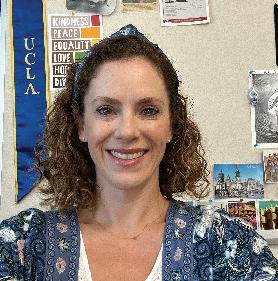
La Señora Gilbert decidió enseñar español justo cuando regresó a los Estados Unidos después de trabajar como maestra de Inglés en Barcelona, España. En el año 2013 fue para la escuela de bachillerato George Washington en San Francisco.
“Toda mi vida he trabajado con niños. Desde jóven siempre me ha gustado mucho,” dijo Gilbert.
“Espero que mis estudiantes aprendan aspectos de la cultura Hispana y cómo mantener una conversación básica que les permitan sentirse cómodos en la calle o cuando están de viaje. [Para] poder conocer, explorar y amar al mundo hispanohablante es muy importante que mis estudiantes sepan como ser la mejor versión de sí mismos. Eso significa aprender la responsabilidad, empatía,
colaborar y escuchar. Esas habilidades son muy importantes para la vida,” dijo Gilbert.
Como el español no es su idioma nativo, la señora Gilbert entiende lo difícil que es aprender un nuevo lenguaje. Ella trata de ser muy paciente con sus estudiantes, pero al mismo tiempo tiene altas aspiraciones para ellos y espera que practiquen el idioma durante su clase.
“En clase me gusta que mis estudiantes tengan la oportunidad de siempre [preguntar] por dos razones. La primera, porque quieren aprender a hablar español y la segunda, que me parece muy importante, es que al no ser nativa del idioma español, al igual que la mayoría de mis estudiantes, puedo entender sus dificultades, hacer una pausa y dejarlos preguntar. Sé cómo se siente estar en una clase muy confusa,” dijo Gilbert.
En España, la señora Gilbert aprendió mucho sobre la cultura hispana y ahora entiende su significado.“Aunque no soy
española, siento que ese país es como mi otro hogar, entonces traigo una perspectiva real a la clase, ” dijo Gilbert.
Además de su trabajo como profesora de español, Gilbert tiene muchos pasatiempos y una vida muy plena. “Tengo un hijo, Adrián, y una perra que se llama Raya. Cuido a mi niño y paso tiempo con mi familia. Nos gusta estar al aire libre y vamos a la playa y al parque porque esta es una etapa muy importante para ofrecer experiencias educativas a mi hijo. Me encanta la música, bailar y por supuesto viajar,” dijo Gilbert.
La Señora Gilbert tiene muchos objetivos para este año y para sus estudiantes. Con su paciencia y experiencia, ella es desde ya una gran adición al grupo de maestros de Redwood.
bark@redwoodbark.org
Mes de la Herencia Hispana en los Estados Unidos


 Por Tallulah Knill Allen, Simon Leonard, Ian Krumwiede y Matthew Knauer
Por Tallulah Knill Allen, Simon Leonard, Ian Krumwiede y Matthew Knauer
En el año 1968, el Presidente Lyndon B. Johnson creó la Semana de la Herencia Hispana para recordar la historia y las contribuciones de los hispanos en los Estados Unidos. En 1988, uno de sus sucesores, Ronald Reagan, convirtió la semana en un mes completo. Dichas festividades ocurren anualmente entre el 15 de septiembre y el 15 de octubre.
Durante su presidencia, Barack Obama reafirmó su apoyo a la importancia del mes y el papel que desempeñan las comunidades hispanas en la cultura y la vida en los Estados Unidos. La celebración informa a la mayoría de la población sobre las vidas y los aportes económicos y culturales de casi 63 millones de hispanos que hoy en día viven en este país.
Los muchos eventos y celebraciones durante el Mes de la Herencia Hispana incluyen música, comida, baile y vestidos típicos que representan la cultura y unifican la comunidad. Igualmente, hay partidos de béisbol con descuentos e incluso, los Gigantes de San Francisco ofrecen una fiesta para celebrar la ocasión. También hay arte, murales y paredes decoradas para propagar los ideales e importancia del mes.

También en la televisión, internet, libros y eventos se habla sobre diferentes personalidades hispanas y sus logros. Por ejemplo, César Chavez lideró el movimiento por los derechos de los granjeros inmigrantes. Creó un sindicato, y al final, consiguió más derechos, mejores condiciones y paga para muchísimos trabajadores. Dolores Huerta trabajó con Chávez y ayudó a liderar el movimiento. Ella también luchó por el registro de votantes y defendió los derechos de las mujeres, los pobres y los inmigrantes. Otro caso es el de Sylvia Rivera, una activista por los derechos de la comunidad LGBTQ+, específicamente transgénero. Rivera creó una organización llamada STAR, que dió refugio a las personas LGBTQ+. El Mes de la Herencia Hispana celebra y recuerda a personalidades como Chávez, Huerta y Rivera, quienes hicieron una diferencia y muchos otros como ellos.
Con frecuencia, los hispanos no reciben todo el crédito que se merecen por su trabajo y sus logros. El Mes de la Herencia Hispana trata de darle ese justo reconocimiento a sus comunidades. Las celebraciones también representan una oportunidad para que la mayoría de los americanos aprendan sobre las diferentes culturas Hispanas, ya que no todos los países latinoamericanos son iguales en cuanto a sus tradiciones,
comida y pasatiempos favoritos.
La celebración del Mes de la Herencia Hispana marca también fechas muy importantes para varios de los países del resto del Continente Americano. Tal es el caso del día de la independencia de cinco países centroamericanos, Costa Rica, Guatemala, El Salvador, Honduras y Nicaragua es el 15 de septiembre. El 16 de septiembre es la independencia de México y el 18 de septiembre es la de Chile.
El mes de la Herencia Hispana representa una oportunidad para recordar a aquellos inmigrantes que no han logrado mejorar sus vidas en los Estados Unidos y se encuentran en malas condiciones.
La información que se distribuye durante este mes ayuda a crear conciencia sobre la necesidad de ayudar a estos trabajadores. Por eso, el Mes de Herencia Hispana tiene mucha relevancia en la vida de todos.
El Mes de la Herencia Hispana es divertido con las fiestas y genera un sentimiento de comunidad. Igualmente es una oportunidad para expander el conocimiento de la cultura de donde proviene casi el 20 por ciento de la población de este país y de ver cómo sus condiciones de vida pueden mejorar junto con la de todo el resto de los americanos. bark@redwoodbark.org
Arte hecho por estudiantes muestra las diferentes nacionalidades de los hispanos en los Estados Unidos
Página 8
Todos los años, Redwood agrega nuevos miembros a su profesorado y este
LA SEÑORA GILBERT sonriendo en su clase de español 3/4 y 5/6.
Foto cortesía por Erin Gilbert
BAILADORES LLEVAN BANDERAS de paises diferentes.
Foto cortesía por AP News
Ilustración por Lauren Olsen Ilustración por Andre Garcia
Ilustración por Andre Garcia
feature feature
Profit over privacy: The unsettling reality of family vloggers
By Elsa Block and Emily Hitchcock
When one takes a retrospective glance at their upbringing, many are fortunate enough to say that those times are cherished in capsules of framed smiles or digitalized giggles kept within the safe confines of a close circle of family and friends. But for an increasing number of children, that is no longer true as their lives are posted online for the world to see, turning those special moments into profit.
This is the premise of family vlogging, a subgenre of YouTube videos where content creators post the details of their day-to-day lives, many of them focusing on their children. According to the Science Survey, the viewers of family vlogging channels increased by 90 percent in 2017. Additionally, family vlogging on YouTube is a fulltime job, especially for the children the families are profiting from. According to Grant Sabatier, creator of the Millenial Money blog, author of Financial Freedom and Co-Founder of Bank Bonus.

The once-successful YouTube channel, “8 Passengers” has recently become a fateful example of the harms of family vlogging. Mother Ruby Franke has been under vast public scrutiny due to the abusive exploitation of her six young children. According to Buzzfeed, Franke was arrested on Aug. 30 and charged with two counts of child abuse with one of the children, who had escaped the home and sought help, found with various open wounds that were duct-taped. The account that once boasted millions of subscribers has now been removed from the internet.
Several other family channels have been under similar criticism surrounding speculation for how they exploit their children for views. For example, the viral ACE Family consistently exploits their children’s innocence, as shown in the video “ELLE GOES ON HER FIRST DATE!!!” when they craft a story that the threeyear-old is going on a date as clickbait, attracting 21 million views. The famous LaBrant family also committed similar acts with the now-deleted viral video
old daughter’s pure devastation when they told her they were giving away their family dog as a joke.
For the children involved, being constantly posted on social media can result in trauma. From losing trust in their parents to gaining issues with self-esteem, therapist Megan O’Donnell shares how exploitation harms development.
“The idea of kids being exploited is bad enough, but when it’s coming from their own family, that’s another level of betrayal and mistrust,” O’Donnell said. “[Being exploited by family] can lead to trauma responses such as avoidance, anxiety flashbacks and so many more situations depending on the level of the trauma they faced.”
Content creators depend on their children for fame without considering the harm they face. For example, the Social Media Victims Law Center states social media is known for its correlation with the risks of sexual exploitation and harassment.
The California Department of Social Services Child Trafficking Response Unit (CTRU) responded to this issue when inquired through an email interview. The CTRU administers the Commercially Sexually Exploited Children (CSEC) Program and supports children who have experienced or are at risk for experiencing commercial sexual exploitation.
“Social media is one place in which children may be recruited in commercial sexual exploitation. Those experiencing commercial sexual exploitation may not even be aware it is happening to them,” the CTRU stated.

Bree Marchman is Marin’s local Division Director of Children and Family Services. Marchman’s role is to support and protect youth and families in the county so that children have a safe and nurturing home, working with the community to report child abuse, neglect or sexual exploitation.
When asking Marchman about her perspective on family influencers, she gave insight into how child exploitation is primarily dealt with through commercial exploitation, which is highly prevalent among family influencers.
“Law enforcement works with us. We might see commercially sexually exploited children, which is when a youth under 18 is involved in the exchange of sexual acts for goods or money,” Marchman said.
Because family influencers rely on commercial exploitation, Marchman describes how to support suffering children by intervening when necessary.
“We work with the Welfare and Institutions Code, [which] allows us to intervene. There’s a newer section of the code from the last ten years that we can get involved in commercial child sexual exploitation.”
become a matter of concern as they grow up. Mary Darin Cline, a Lick-Wilderming High School graduate and viewer of family channels, fears for these children who have to grow up with an online presence.

“If I were a kid, I would not want to look back 15 years later and see myself online. I would not have been okay with that, and I think that parents [should consider that aspect before posting those videos],” Cline said.
The exploitation of children in the entertainment industry is nothing new, resembling the phenomena of child stardom, assisted by parental exploitation of their children. A new Illinois law that goes into effect on Jan. 1, 2024, will make it the first state to add children posted on social media to the state’s Child Labor Law. mirroring the 1939 Coogan Law created when exploited child actor Jack Coogan expressed anger for his child stardom profits that were out of his reach. It ensured that 15 percent of a minor’s earnings would be set aside in a “Coogan Account,” or a similar account that children can access once they are adults. Similarly, the new Illinois law states that children aged 16 and under be compensated within 30 days if they are in at least 30 percent of online content for which the adult, whether parent or caregiver, is being paid. The money will be put into a trust until the children are 18 to access it.
For viewers of these family channels, passing this law is essential. Many, including Cline, favor the law and think it is necessary for the children’s futures.
“If a parent is [depending on] their children who are the center of the profits, I think the kids deserve compensation,” Cline said.
“If people go to see a Broadway show, you pay to see the performers; they entertain you. The entertainment [needs] to be paid.”
However, the new law raises the question of whether financial compensation is enough for the emotional damage that children face. Josie Smith, a junior with experience interacting with family vloggers through social media, is wary of the law’s ethics.
“[The law] doesn’t help the emotional well-being [of the children]. They’re getting money, but I don’t think it’s enough for their emotional well-being. I feel like family vloggers should keep their kids out of [their social media] until they’re old enough [to decide] to participate,” Smith said.
Smith is no stranger to family influencers, with their vast popularity on social media. When Smith was younger, she used to watch these influencers. But as she grew up, she realized that the content was not as innocent as she once perceived.
“When I was a kid, I did not see issues with family vloggers at all. But now that I’m older, I see something wrong with it because they’re exploiting the children [as seen with 8 Passengers] when the mom got sent to jail for abuse,” Smith said.
While they are young, they may not think anything of it, but this could bark@redwoodbark.org
Page 9
THE FRANKE FAMILY pictured years before Ruby’s arrest.
Photo courtesy of Marca
By Charlotte Fishburne and Alana Leifer
In January 2020, a week after his 16th birthday, Shayne Rebbetoy-Hudson, a sophomore at Archie Williams High School, took a large dose of psychedelic mushrooms alone in his house. Shane experienced an out-of-body, hallucinogenic sensation in which he believed he could fly. Not used to seeing Shayne in this euphoric state, his parents decided to take him to the hospital. While preparing to leave, Shayne got up and ran off their 40-foot-tall deck with his arms out yelling, “I’ve got this, I’ve got this.” He passed away in his father’s arms.

“So many people [told us] how much of an impact Shayne had on their lives. He was kind, compassionate, energetic and was always looking out for his friends. He was a bright, brilliant, sparkling soul,” Lisa Hudson, his mom, said.
Following her son’s passing, Hudson has become an advocate for education surrounding psychedelic drugs. She is one of the founding members of the Coalition of Psychedelic Safety, an association opposing California’s proposed Senate Bill 58 — which would decriminalize psychedelic drugs. The coalition was founded in Marin County by mothers who lost their children to mushroom-related incidents. They connected with a group of medical professionals, University
passing of this legislation. Hudson voices concern that California is moving too fast in the decriminalization process and not considering the immense risks, especially for younger individuals.
“I have a lot of gratitude for being there [when Shayne passed away] and seeing his state of mind and not [instead] finding him in the backyard the next morning,” Hudson said. “In Shayne’s case, I think it shows you how, even when you’re having a euphoric experience, your judgment’s impaired, you’re hallucinating and you’re making bad decisions.”
Senate Bill 58:
Senate Bill 58, passed on to Governor Gavin Newsom on Sept. 13, would go into effect in January 2025 if approved. This would decriminalize natural substances including mescaline; Dimethyltryptamine (DMT), an active ingredient in ayahuasca; psilocybin and psilocin (the compounds found in magic mushrooms). Synthetic and chemical derivatives are excluded. The bill specifies that the California Health and Human Services Agency would be required to form a work study to govern the therapeutic use of those substances.
While the proposed bill establishes a research period to decide how to best initiate the therapeutic program, the personal usage side of the bill has little to no safeguards in place.
“Since 2016, hospitalizations due to psychedelics have gone up 84 percent. 70 percent is personal usage versus therapeutic usage, [according to Stanford University research]. And that’s even with it being illegal at this point,” Hudson said. “Education is a key to risk mitigation, harm reduction and safety. We get more information on a bottle of aspirin!”
Beth Parker, another founding member of the Coalition for Psychedelic Safety, is familiar with the legal process through her experience as Head Legal Council for Planned Parenthood.
“What we were really pushing is that [before decriminalizing] personal use, [there] should be put in a workgroup [where] you have experts come up with recommendations for what those safeguards should be,” Parker said. “That’s what 20 other states [that are developing similar programs] are doing. They’re establishing a workgroup first, to come up with recommendations, and implementing those recommendations before they do the decriminalization.”
Shayne Rebbetoy-Hudson was everybody’s best friend when he passed away at 16. Friendly, passionate and fierce, his childhood nickname “bottle rocket” represented his energetic spirit.
Other Program Models:
Currently, Oregon is the only state to have fully decriminalized psychedelics. Oregon Ballot Measure 109 set specific guidelines that would be overseen by the Oregon Health Authority, including monitoring psilocybin production; manufacturing requirements and licensure; mandatory testing of purity and potency; and facilitator qualifications, training and

licensure.
The use of psychedelics as a tool for therapeutic purposes is revolutionary. In fact, the U.S. Food and Drug Administration has labeled it a “breakthrough medicine” for treating depression, anxiety, posttraumatic stress disorder, cluster headaches, anorexia, smoking addiction, substance abuse and more — all conditions where patients have low serotonin levels. While selective serotonin reuptake inhibitors (SSRIs) can be effective in improving overall serotonin, they take months to kick in, and using psychedelics in a controlled environment can yield results after just one session. According to a September Bark Survey, 20 percent of Redwood students have been prescribed antidepressants. Psychedelic treatment could be a potential consideration once they turn 21.
Data analyst for Oregon Psilocybin Services, Jesse Sweet, shared more about the structure of their program.
“In Oregon, we don’t have a consumer marketplace for psilocybin, we have a client based wellness model. And that’s different from anything else. It’s not like a [marijuana] dispensary where you can just go buy it. But it’s also not a medical model. It doesn’t require a prescription, it doesn’t require any type of medical condition to receive the services. So it’s a very unique type of program,” Sweet said.
As the first state to decriminalize psychedelics and even encourage them in a supervised setting, Oregon has approached their program with curiosity and care, prioritizing education and safety.
“Our model requires that the psilocybin be consumed at the service center where it is purchased. So it’s not as if people will be taking these products away from the service center where they can get into the hands of young people — every client needs to be over 21,” Sweet said. “So it’s not like alcohol, for example, where young people could be getting it out of their parents’ liquor cabinet.”
William Nash was an avid adventurer and entrepreneur when he passed away at 21. Embodying “true joie de vivre,” he enjoyed skiing, cooking and spending time with his loved ones.
Since 2016, hospitalizations due to psychedelics have gone up 84 percent.
Stanford University Research
Profit vs. public safety – the contradicting priorities of the bill:
Oregon’s success creating a secure program surrounding the therapeutic usage of psilocybin raises the question of why California’s approach to personal use regulation has so few safeguards. Parker argues that the disregard is a result of disproportionate focus on personal gain, rather than what’s best for the general population.
“My view is [that] the bill is being pushed by people who make a lot of money by selling these products, and then are not being responsible and caring about the people who are going to take them without instructions and knowledge of [these products’] risks,” Parker said.
What the Coalition for Psychedelic Safety wants to see reflected in this bill is for the personal program to reflect the same structure as the therapeutic aspect. Hudson also feels frustrated by her experience advocating for these safeguards.
“When I was up at the Health Committee in Sacramento to protest on
behalf of this legislation, Assemblyman Woods, who was the chairman, said, ‘We do see that we’ve made some mistakes with legalization of marijuana; that it rolled out a whole bunch of products to our kids that have more access now.’ He then went on to say, ‘I understand there’s concerns with psychedelics, but I made a commitment to Senator Wiener, so I’m going to pass this bill along.’ So, for me, this whole political process has been a real eye-opener about how hard it is to get our representatives to see that legislation like this has an impact,” Hudson said.
The differing perspectives of psychedelic drugs:
William Nash was a senior at Middlebury College when his life came to a sudden end at only 21 years old. As a skier, pole vaulter and aspiring entrepreneur, he was just starting his life. William was experimenting with psychedelics with a group of friends when, like Shayne, he underwent an adverse psychotic reaction.

“His friends expressed that they never dreamed that things could go so sideways,” Kristin Nash, his mother, said. “At some point he grabbed a jug of protein powder, and shook it on his face as if he was drinking water. He asphyxiated and died almost immediately.”
The bill would limit the amount that can be in someone’s personal possession to one ounce, or 28 grams. This is 14 times
Education is key to risk mitigation, harm reduction and safety. We get more information on a bottle of aspirin!
Lisa Hudson, mother of victim
Photo courtesy of William G. Nash Foundation
Photo courtesty of Lisa Hudson
chosen to remain anonymous, claims to have had a positive experience.
Up until her experience, Lily had maintained a negative outlook on all drug usage. Even so, she saw other substances, particularly alcohol, as a more significant threat than psychedelics.
“My parents are very against [psychedelics]. Ever since I was younger, the [people around me were] like, ‘It will change your brain, it’s not good for you,’ only [speaking about] the negative aspects,” Lily said.
Following her encounter with psychedelics, Lily felt fundamentally different.
“By the time [my friends and I] were leaving that house [after taking mushrooms], [we] felt changed. It’s a weird sensation. The following days you have a sense of clarity,” Lily said. “I’m a road rager, and the next three days I didn’t have road rage. I would sit in traffic and not get pissed about it.”
Although Lily’s personal experience has been positive, she recognizes that not everyone has the same reaction to psychedelics.
“I did the shrooms with one of my female friends and her boyfriend and she had a really bad experience. She told me that she felt suicidal the whole time and said, ‘If I die now, now would be the time to die,’” Lily said.

As Senate Bill 58 sits on the desk of Governor Gavin Newsom awaiting his decision on the future of psychedelics for Californians, the Coalition for Psychedelic Health and Safety urges people to educate themselves on psychedelics and take action to demand more safeguards in the bill.

“What I would like to do is have nuanced conversations about these compounds as we think about legalizing them and bringing them broader into society, so people can harness the benefits, and we can — as much as possible — mitigate the risk,” Nash said. “If we could save one life, that would be an amazing legacy.”
bark@redwoodbark.org
Infographic by Alana Leifer
From dream development to sunset scope The story of Marincello’s abandoned dream
 Story and Illustration By Lauren Olsen
Story and Illustration By Lauren Olsen
Drive up the side of the Marin Headlands, past the towering Golden Gate Bridge, and there lies the Marincello trail — a rugged path that winds through pastoral landscapes. The view is strikingly bare: a vast expanse of deep blue ocean extending as far as the eye can see. It is almost inconceivable for one to fathom that this very land had once been marked for a massive suburb, a bustling community that never came to fruition.
In the early 1960’s, Thomas Frouge, a developer from Bridgeport, Connecticut, had a fascination for the land of Marincello and the grand development he could make on it. Eager to build his fantasy, with help from the Gulf Oil company, he purchased the 2,139 acres of land and made plans for this new Marin community, to be named “Marincello.”
Senior Gabby Hoeberichts, when learning about Marincello in her high school class, also became fascinated with the vision of the potential community.
“I’m in a program at [Tamalpais High School] called Academy of Integrated Humanities and New Media (AIM). My teacher mentioned [Marincello] in one of our classes and it hooked me,” Hoeberichts said.
Hoeberichts went to the Mill Valley Public Library and asked if they had a folder on Marincello. She went in with the expectation to not find anything, but instead discovered old articles from
At the time the project was proposed, a small group of activists, known as the Golden Gate Headlands Committee, opposed the development. They presented a petition bearing 6,000 signatures to the County Board of Supervisors regarding the Marincello project, but it was disregarded. A subsequent petition submission was discredited when the county invalidated 300 signatures and proceeded.
In Nov. 1965, Marin County officially granted approval for Frouge’s plan, giving the green light for building. Soon after,

found that they didn’t give 10 days for public opinion [regarding Marincello], they only gave seven.”
As highlighted by Kelly’s film, the efforts and sacrifices of Praetzel and other lawyers went financially unpaid Additionally, they encountered significant challenges and adversity.
“They had families. They were young men with young families. They all had day jobs. They managed to fight for this. They were doing this at a time when environmentalism [barely] was a word,” said Kelly.
fate. Ultimately, the National Park Service acquired the land in 1965, putting an end to the dream of Marincello. The proposed suburban community would remain unrealized, and the Marin Headlands was preserved, untouched by the specter of suburban development.
The story of Marincello serves as a cautionary tale: A reminder of the enduring struggle between development and conservation in the face of evolving urban landscapes.
According to the Sept. Bark Survey, 44 percent of Redwood students visit the Marin Headlands at least once a month.
Junior Sadie Hann frequents the Marin Headlands with her family and friends. “It is just a really peaceful [place] and a good way to disconnect,” Hann said.
The Marin Headlands, once threatened by urban sprawl, now stands as a testament to the power of preservation. It offers visitors a chance to experience the unspoiled beauty of nature, with hiking trails, scenic overlooks and a deep connection to the land’s rich history. As we reflect on the rise and fall of Marincello, we may be reminded that actions have consequences, and the choices developers make can have a lasting impact on our environment. Marincello may have failed to become a suburban utopia, but its legacy lives on in the natural beauty of the Marin Headlands, a place where nature and history converge in harmony.
By 1966, Marincello’s budget had swelled far beyond its initial estimate of a lolsen@redwoodbark.org
bark Page 12 • Feature October 6, 2023
They had families. They were young men with young families. They all had day jobs. They managed to fight for this.
Nancy Kelly, filmmaker
Proposed 1970s, Marincello development covering Hawk Hill and Rodeo Valley
Photo courtesy of Victoria Bogdan and Alfred Twu
Living in a made-up world: Unveiling the power of makeup on self-perception
By Tallulah Knill Allen and Linnea Koblik
A brush of mascara against a wellcurled eyelash, a dash of concealer under the eyes and if the day calls for it, a dab of blush across the cheeks. Amid an otherwise hurried day, a makeup routine such as this can provide a moment for self-reflection, and for some, a chance to express their creative side.However, beneath the surface of a simple routine lies a more sinister truth – makeup, for many young girls, has become an integral part of their self-perception. Observing conversation and climate at Redwood, it becomes apparent that for many, the act of going to school without makeup can feel like a Herculean feat — as if daily makeup has become an act of selfpreservation rather than selflove. In a world increasingly consumed by social media, developing a healthy relationship with makeup can be crucial to preserving a sense of selfacceptance beyond the standards of the day.
Throughout history, the use of makeup has evolved to fit societal norms.
First examples of the use of makeup include ancient Egypt, where
became essential to the pursuit of this beauty standard, as former Women’s History teacher Ann Jaime noted.
“Movies shifted [the beauty standard] because they popularized certain images that women aspired to [attain], so there was more conformity,” Jaime said. “My mom was a child of the 50s, and she and her friends say, ‘Never leave the house without lipstick,’ even to this day.”
Today, as social media becomes more prevalent in girls’ lives, it can blur the line between creativity and conformity in makeup. Junior Delfina Serrati describes that in her childhood, she followed makeup tutorials by YouTube artists such as KittiesMama and James Charles, as a source of creativity free from judgment. However, as she grew older, her relationship with makeup began to change.
“When I was younger, [makeup] used to be a vessel to express my creativity. But as I got older, I saw it as a way of hiding my insecurities, like a mask to the world,” Serrati said.
Similar to Serrati’s experience, television led junior Cat Aldana to believe
knowledgeable. I am not this 12-yearold girl who is naive and doesn’t know anything about the world,” Serrati said. Makeup can also lead individuals to develop a different understanding of their own appearance — a phenomenon that is exacerbated as makeup becomes an essential aspect of girls’ lives at an increasingly early age. For Aldana, using makeup more frequently throughout middle and high school shifted her self-perception as she grew accustomed to seeing herself with makeup at all hours of the day. “Because I do use [makeup] every day, I’m not used to seeing my face without makeup anymore,” Aldana said. “I don’t feel ugly without makeup — I just don’t feel as secure.”
While makeup can perpetuate a problem of conformity, it is also important to recognize the value it serves for many as an outlet for self-expression, through which girls today can discover their inner beauty.
“As I matured, I started to use my makeup in ways that I didn’t use it before — not as a way to hide, but more to enhance my own beauty,” Serrati said. “[It’s important to] look in the mirror, look at yourself and think, ‘This is me, and that’s okay.’”

As beauty secrets are passed down through generations and as groups of friends apply blush and eyeshadow before a school dance, a new source of community is formed: one founded not in the search for beauty, but in the connection created through it. Jody Friedericks, who previously worked in makeup marketing and at a Saks Fifth Avenue makeup bar, explained how makeup allows her to access a depth of confidence otherwise unattainable. Beyond individual reflection, however, Friedericks notes the unique connections that are created through common experiences with makeup.
“There is bonding when a group of people are all getting ready, doing their makeup together, helping each other or borrowing something
from somebody,” Friedericks said. “[Working with clients] was so rewarding for me because I could tell that they felt beautiful. But to me, [the makeup] was just highlighting their inner beauty and [the features] that were unique to them.” Similarly, the moments Serrati shares with her mom while getting ready together have enabled her to find a deeper, more meaningful relationship with makeup and with her own beauty. “I love getting ready with my mom. It’s such a fun time because I get to teach her and she gets to teach me. … But it’s also [a time] to be creative and to feel beautiful and empowered,” Serrati said.
As Friedericks illustrates, while makeup has allowed generations of women to express their identities, it's important to keep in mind that makeup, and the beauty it achieves, is only skin deep; external appearances should never determine self-worth.

“I don't think that makeup makes you beautiful. I think that makeup is a tool that allows you to find beauty from within,” Friedericks said. “One of the hardest things to learn as a girl, especially today, is to love yourself. I truly believe that true beauty comes out in the way you feel.”
bark@redwoodbark.org
bark www.redwoodbark.org Page 13 • Feature
I’m not used to seeing my face without makeup anymore. I don’t feel ugly without makeup - I just don’t feel as secure.
Cat Aldana, junior
My mom was a child of the 50s, and she and her friends say, ‘Never leave the house without lipstick,’ even to this day.
Ann Jaime, teacher
Illustrations by Ava Stephens
review review
Explore these autumn adventures and attractions
By Anna Youngs
Fall is here, and with it comes a plethora of fun fall activities! From carving a pumpkin to taking an outing to a corn maze, here are some of the best fall activities to do in Marin.

Pumpkin Carving: Grab a pumpkin, a few carving tools and some friends for this age-old tradition. Pumpkin carving originated as a way to frighten the spirits away from people’s homes. Now, it has turned into a fun activity that not only produces an artistic Jack-o-Lantern but a delicious snack. Throw the pumpkin seeds onto a pan and season them with spices for a fall snack. Whether you decide to create a classic Jack-o-Lantern or something more creative, pumpkin carving is a great way to kick off your fall with some spooky decor.
THE
Patch offers a variety of colorful pumpkins.
Pumpkin Patch & Corn Maze:
Located off Highway 101, The Petaluma Pumpkin Patch and Amazing Corn Maze is open for its 31st season this fall! This pumpkin patch has an entire pit of corn that you can go in. It sounds a little strange, but it is definitely something unique and fun to try. After that, there is a wide variety of pumpkins and squashes. There is an entire field to choose from, with the option to hand pick one off the vines or to grab one of the pre-picked pumpkins at the front. They also have the legendary
‘Amazing Corn Maze’ that is guaranteed to stump its visitors upon entering. If you’re clever, you will make it out okay and have a great time. Additionally, there are a few types of animals housed at the pumpkin patch. They have horses, cows, turkeys, chickens and even a calf. Overall, this pumpkin patch is well worth the 35 minute drive.
Halloween Movie Night:
Gather around the TV with friends or family, queue a Halloween movie and
grab some delicious fall snacks and treats to share with everyone! Whether it’s pumpkin pie, apple crisp, snickerdoodles or candied apples, there are many fall recipes out there to satisfy all different cravings. From comedies to thrillers, there is a broad spectrum of Halloween flicks to watch. A classic thriller that many people enjoy watching is the Scream saga. With six films to its name, this franchise has grossed a total of $911 million at the box office. “Scream” is a personal favorite of mine because of its star-studded cast and plot twists. Besides “Scream”, a Halloween comedy that is less scary and a little more wholesome is “Hocus Pocus”. Both movies are a great choice and festive for fall!
Enjoy the bounty of fall activities that we have access to in Marin and try any of these great options. Carve a pumpkin to scare away spirits, binge some Halloween movies or take a trip to the Petaluma Pumpkin Patch to get the most out of the autumn months this year.


ayoungs@redwoodbark.org
You won’t be-leaf these vegan options around Marin
 By Beckett Tudor
By Beckett Tudor
Plant-based eating has exploded in popularity in recent years, with many Redwood students looking throughout the Bay Area for vegan alternatives to their favorite traditional dishes. Scattered throughout Marin, there are many restaurants to grab a plant-based meal, each providing their own unique ways to accommodate the new and popular vegan diet.
Amy’s Drive Thru, located off of Highway 101 in Corte Madera, features a fully vegetarian menu, with every item having both a vegan and glutenfree alternative for a 50 cent upcharge. Their diverse selection of items follows a traditional style of American fast-food restaurants, ranging from grilled cheese sandwiches, to chili fries and pizzas. The drive-thru consists of both large outdoor and indoor seating areas with plenty of natural scenery to create a wholesome aesthetic. Friendly workers and tasty food
make up for the slightly expensive prices, costing around $15 for a full meal. Besides the price, Amy’s is a must-try for an allvegan experience conveniently close to Redwood.

If you’ve got a sweet tooth, Frankie and Joe’s is the perfect place for you. Located in Marin Country Mart, Frankie and Joe’s offers a variety of flavors as well as three seasonal options which change monthly. They are open from 11 a.m. to 9 p.m. daily, making them a perfect stop for a scoop before getting on the ferry. The shops surrounding Frankie and Joe’s are classy, with an incredibly clean seating area and a quaint feeling to enjoy. As for the ice cream, I ordered the peaches and cream, a September seasonal flavor. It was six dollars for a mini scoop, which I would recommend as the best option for the most reasonable food to price ratio. Having just the right amount of sweetness combined with a small element of zest, it makes a refreshing treat for a hot day.
Known by many around Marin, World
THE CHIMICHURRI WRAP boasts unique flavors with a vegan twist. options costing $13 and $18 respectively. That being said, World Wrapps makes up for this bulky price in fantastic ambiance and is a prime location for students interested in international vegan options. While not every restaurant in Marin offers a vegan or vegetarian option on the menu, those that have them do not disappoint. Amy’s Drive Thru, Frankie and Joe’s and World Wrapps are some of the best plant-based choices around Marin for any student hoping to add more variety to their diet.
Wrapps is an incredibly popular fast-casual restaurant located in the Corte Madera Town Center. It’s a go-to spot for students grabbing a bite during lunch, after school or on the weekends but many are unaware that they offer two fully plant-based versions of their most popular items. The teriyaki bowl and the chimichurri wrap can both be made entirely vegan with tofu and Beyond Meat. In my opinion, the teriyaki bowl was slightly too simple. It was very filling, but had classic flavors. The chimichurri wrap was the better option of the two, being incredibly flavorful and filled with protein. The quality food does come with hefty price tags, with the
btudor@redwoodbark.org
Page 14
PETALUMA PUMPKIN
“The Amy” burger has a classic burger taste and a gluten free bun option.
Photo by Anna Youngs
Photo by Beckett Tudor
Photo by Beckett Tudor
Illustration by Ava Stephens
Illustration by Ava Stephens
The ultimate guide to Marin’s top theaters
By Henrik Vraanes
With winter just around the corner, many Redwood students are looking forward to enjoying holiday movies with their friends and families, but they are stuck with deciding which movie theater is the best in Marin. Each cinema has its share of uniqueness, but which one stands out the most?


$10.25, you get a decent experience, but the location is inconvenient, especially since there is a large, empty mall you must walk through to get there.
Cinelounge
The Cinelounge recently opened in August of 2022 after previously being called the Tiburon Playhouse. Positioned in the middle of downtown Tiburon, it is a prime location for people who live in the area or for those visiting. The Cinelounge Theater is busier than Century Northgate, so it would be wise to book tickets in advance. The seats in the cinema are extremely comfortable, with soft padding,
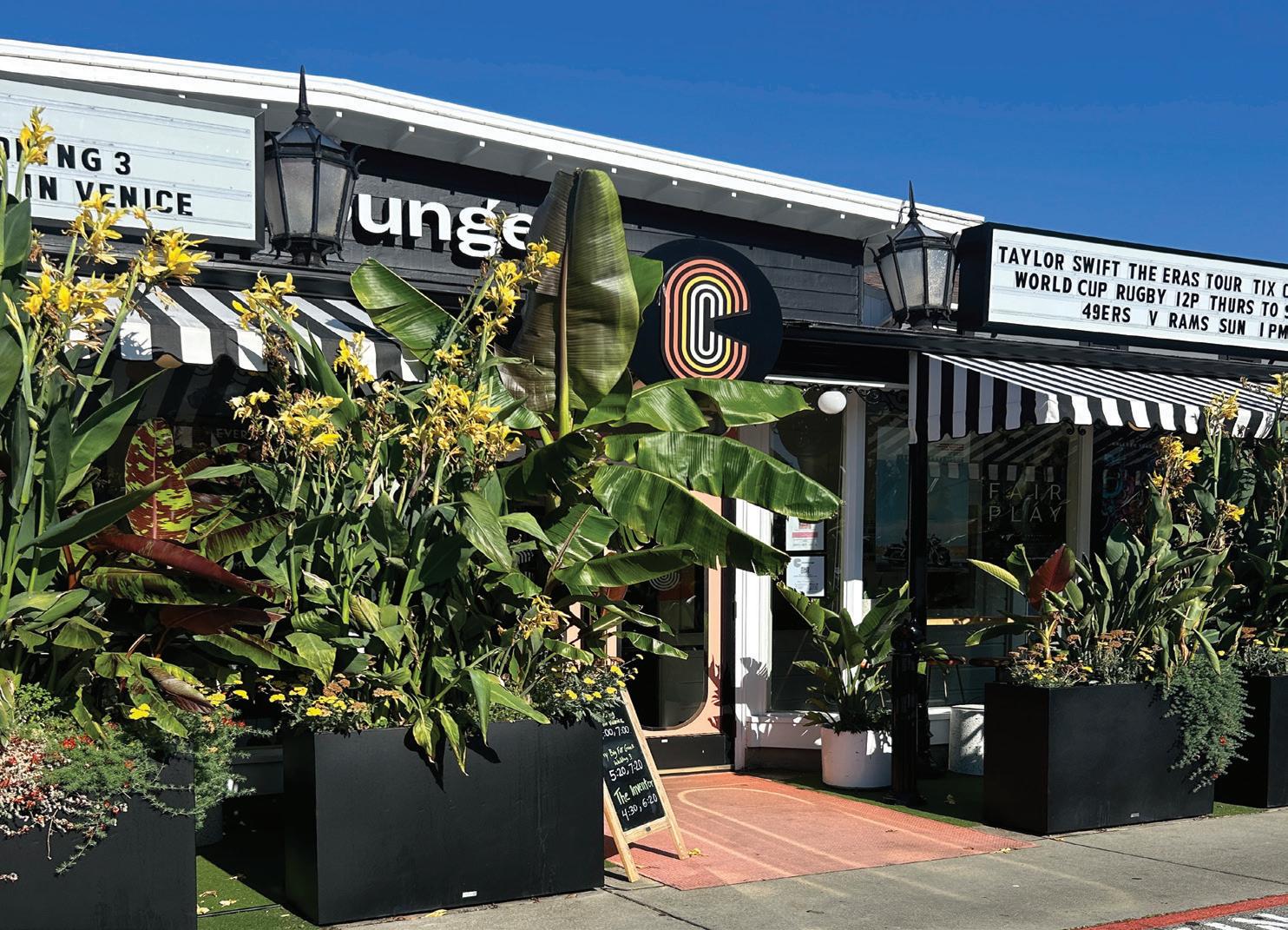
which surpasses many theaters in creativity and comfort. However, the pricing is less affordable than the rest, reaching $15.99 per ticket. Although it is quite expensive for merely watching a movie, the experience and location of the theater are good selling points for Redwood viewers.
Larkspur Landing Cinema
The Larkspur Landing Cinema is located next to the Marin Country Mart, with many restaurants and other attractions in the nearby area. The Larkspur Landing Cinema isn’t very crowded, but it doesn’t take away from its quality. The leather lounge chairs in the cinema add a sense of
Century Northgate
Located in Northgate Mall, Century Northgate used to be the hot spot for moviewatching. This theater is difficult to find because it is situated towards the back of the mall, and there weren’t many people in the theater, nor many in the mall itself. This made it easy to book a seat and enjoy the movie. The sound quality is better than the average theater, with clear and loud audio. The seats are pretty average, consisting of classic movie theater chairs with regular cushions and padding. With a price of
luxury to the theater’s environment. Not to mention, they can recline and have a small table to store snacks. This theater is also the cheapest on the list, with a reasonable price of $10. The price for a movie is worth it because of the quality you get from the seats and the centralized location of the cinema.
With every movie theater having its own unique aspect, the Larkspur Landing Cinema seems to be the best option for Redwood students as it’s the cheapest and features the best moviewatching experience.
hvraanes@redwoodbark.org
Explore these creative outlets around the Bay Area
By Linnea Koblik
From a young age, humans experience the joy of artistic expression. Even though we might be past the years of finger painting and drawing on walls, we can still exercise our creativity through different outlets, such as pottery glazing or candlemaking. The Bay Area offers many creative spaces for art projects like these, where considerations such as cost, convenience and atmosphere each play an important role in making the experience worthwhile.
Terra Mia
Located in Noe Valley, San Francisco, is Terra Mia, which offers a unique pottery painting experience each day of the week. The business was established in 1994 and has flourished ever since, inviting artists of all levels to practice their craft. Terra Mia carries over 100 pottery shapes including vases, mugs and dishware, along with over 50 glazes that individuals can
select from. Terra Mia has an affordable price range, with unrestricted studio time amounting to $15 per person and pottery ranging from $6 to $50. While working on projects, visitors can enjoy the view of



Noe Valley’s bustling streets and savor the sight of people painting around them. The studio includes multiple large and small round tables, making it the perfect spot for traveling solo, or for bringing a group of friends to tap into self-expression.
Moonshot
This fragrant haven, located on the corner of Castro St. and 24th St. in San Francisco, provides a serene space to create signature scents with candles, sprays and reed diffusers. Open Tuesday through Sunday, the studio offers over 80 fragrances to choose from, which can be mixed together to create a unique and custom product. Custom candles begin at $34 and sprays start at $16. When making a candle, participants also learn the process of blending scents and pouring wax into a chosen mold. As relaxing aromas fill the room and friendly employees offer their assistance, one can’t help but spend hours working on a special project.
Studio4Art
This vibrant art space located in downtown San Rafael welcomes all forms of creativity, including wheel throwing, pottery painting and art kits. Drop in between 9 a.m. and noon on Saturdays to experiment with new forms of art at any level. Studio time is free and includes your choice of paint color and brush size, while pre-fired pottery pieces range from $10 to $80. In addition to pottery painting, Studio4Art offers beginner wheel throwing lessons, making it the perfect place to learn from experienced instructors. The studio has a fun family-friendly atmosphere, providing inspiration for participants to explore their creative potential. Whether painting pottery or making candles, fueling the desire to create is essential to living a healthy and balanced life. Busy school schedules can make it challenging to find time for expressing one’s creativity, yet these activities are an important outlet for self-expression and stress relief.
lkoblik@redwoodbark.org
bark www.redwoodbark.org Page 15 • Review
GLEAMING IN A sea of greenery, the Cinelounge invites visitors to the luxury theater.
Photo by Henrik Vraanes
STACKING TO THE highest shelf, Terra Mia offers a variety of pottery to paint.
Photo by Linnea Koblik
BEAMING WITH NATURAL light, Studio4Art provides a welcoming space for beginners to create art.
Photo by Linnea Koblik
DISPLAYING A VARIETY of pre-fired options, Studio4Art creates a place for everyone.
Photo by Linnea Koblik
Illustration by Ava Stephens
Illustration by Ava Stephens
sports sports
Samantha Haan shines as field hockey’s star player

 By Ashlin Quach
By Ashlin Quach
“I have a lot of determination to win. I’m super competitive, which is probably one of my biggest strengths. I never give up, try to stay positive and help my team while motivating others,” Haan said.
Haan’s ambitious mindset, along with her remarkable statistics of 20 goals and 18 assists, helped her win MCAL Player of the Year as a junior, but it came with a lot of hard work and commitment over the past couple of years.
“I worked hard for a long time. [The summer] going into my junior year [during the offseason], I attended many [field hockey] camps. I went to Florida twice and Pennsylvania once [for camps].
I was working all year to improve my skills,” Haan said.
In addition to her work ethic and competitive drive, Haan has shown strong leadership both on and off the field. As a team captain, she has demonstrated her ability to
rally her teammates and provide vocal encouragement. Senior co-captain Maisie Pipitone has experienced this firsthand.
“She really uplifts the quality of our playing and she pushes all of us to [perform at] our best. She is very vocal on the field but she also is very celebratory. If we do something really well, you [can] just immediately tell that she’s very prideful and a great person to be around [on and off the field],” Pipitone said.
The younger players on the team also feel Haan’s contributions and think of her as a role model, as she is constantly trying to help them improve their skills while also working on her own.
“You can tell that [Haan] wants to get better at a skill, or she wants to develop a new trick or go back and try something new. And I think that’s a really good growth mindset that she encourages the younger players to have,” Pipitone said.
Haan has a strong aspiration to continue playing field hockey at the collegiate level but is particularly interested in joining a club team rather than pursuing opportunities in Division I (D1) or Division III (D3) programs.
“I would play club field hockey in college, but I don’t want to go D3 or D1 because
[playing] D1 is a big commitment. I’m not sure I want to have that commitment for four years, but rather I want the opportunity to still play the sport I love with less pressure,” Haan said.
Some of Haan’s top schools she would like to attend for college are the University of California, Los Angeles, the University of San Diego and California Polytechnic State University in San Luis Obispo (Cal Poly). Haan’s sister currently attends Cal Poly and plays club field hockey there which has
contributed to Haan’s determination to attend Cal Poly as well.
Regardless of whether Haan chooses to pursue her career at the collegiate level or not, her journey thus far has been one to remember. Her high school career in field hockey has embodied determination, competitiveness and strong leadership, which are certain to resonate throughout the team and program for years to come.
aquach@redwoodbark.org
Women’s flag football touches down in Marin County
By Charlotte Lacy
After winning the US Open at the young age of 19 on Sept. 9, 2023, Coco Gauff showed young athletes worldwide that anything is possible. To encourage the emergence of more exceptional female athletes similar to Gauff, the California Interscholastic Federation (CIF), which is the governing group for high school sports in California, approved women’s flag football on Feb. 3, 2023.
After the approval, two high schools in Marin County jumped at the chance to create teams: San Marin High School, with 23 players and Terra Linda High School (TL), with 16 players.
Ellie Gilbert, a junior on the TL team, is the running back for the Trojans and worked to start their women’s flag
football team. Gilbert is involved in the San Francisco 49ers Foundation, which provides free access to training and resources to start flag football leagues across the Bay. Gilbert has used the resources the foundation has provided to help start TL’s flag football team.
“I had been working with the [San Francisco] 49ers and their youth foundation. I expressed interest [in starting a flag football team] before it became a CIF sport. Then, I brought it up to our athletic director, Mr. Farbstein, [and] he said that if we could get a good group of girls together, we could start off as a club until it becomes a CIF regulated sport,” Gilbert said.
Following the support of Farbstein, Gilbert created a flag football club that helped the sport gain popularity and allowed the players to learn the rules. After
gaining enough players, 11, more than a year after establishment, the Trojans had their first official game of the season on Sept. 13. While the Trojans were defeated 12-19, the team was exhilarated by the chance to have played a real game.
“It was the most exhilarating moment [our team has] had. To know that we finally got to that point where we were playing our first game of high school football, was the most amazing feeling ever. Win or lose, everyone was just thrilled to be there,” Gilbert said.
Gilbert hopes to see all the schools in the Tamalpais Union High School District (TUHSD) start a team, as she believes the sport will continue to gain popularity.
TUHSD schools are yet to have flag football teams, but athletic director Jessica notes that there is a process for adding an 8th sport to the fall season for Redwood’s female athletes.

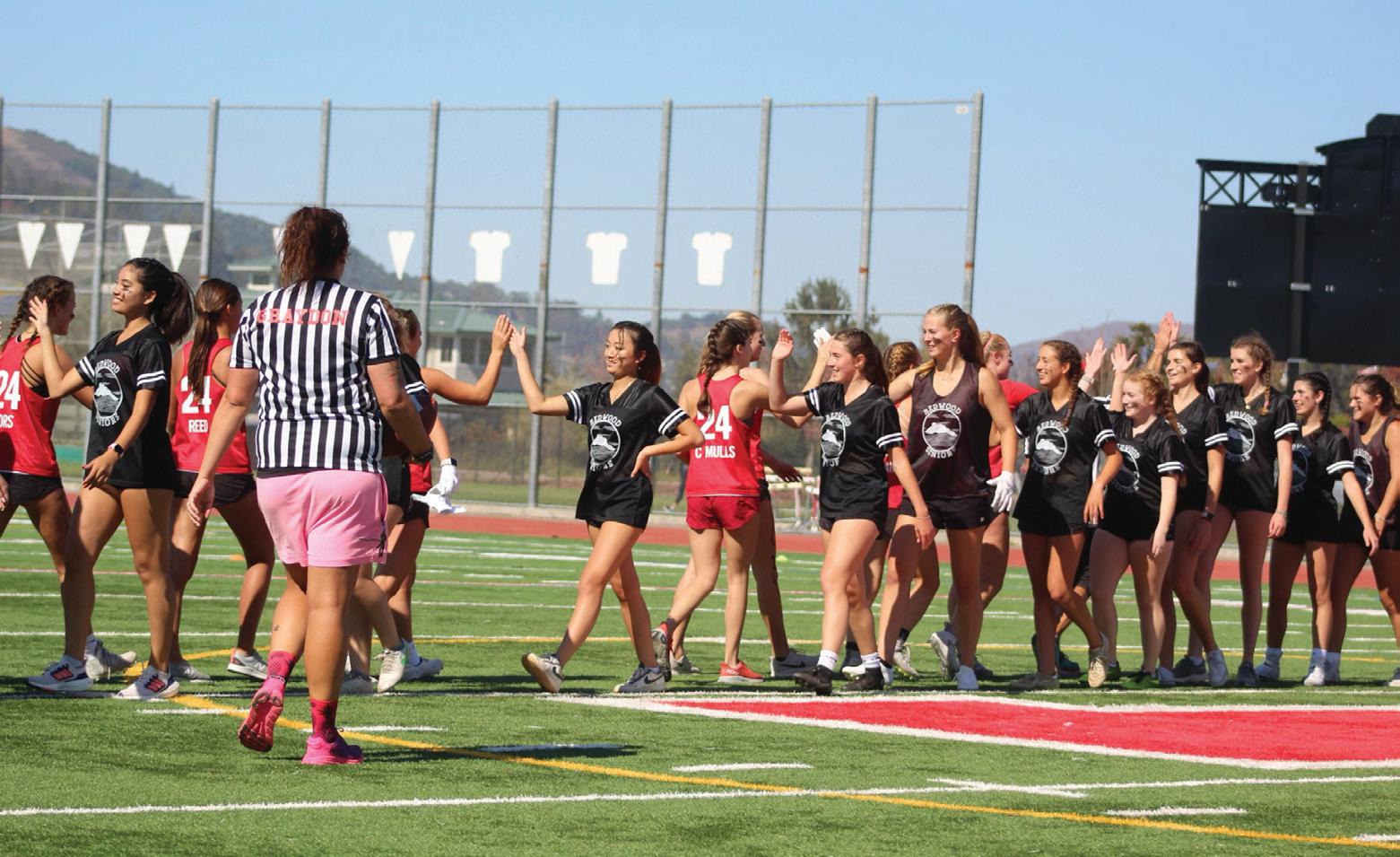
“The criteria for adding a TUHSD athletic team is that it must be a CIF approved sport and there must be interest from the community. So what we do in this situation is if students come and say hey, we’re interested in having a team, we would do informational meetings. I will talk about what the season looks like, what the practices and games look like because
then there must be interest in adding the sport for all three [TUHSD] sites,” Peisch said.

Junior Maya Saibel, who currently plays field hockey and basketball, hopes that Redwood will work to start a flag football team. Saibel has experience with the sport and competitive nature of the game, as she was the quarterback for her all girls flag football team in 2020.
“My team was in the Next Level League, a boys’ league. We had a lot of fun competing against the boys and getting the opportunity to play flag football,”
Saibel is looking forward to playing football again this upcoming October, as Redwood hosts a “Klassy Kickoff” girls’ flag football game every year during Homecoming. Recently, it has become so popular that a lottery system has been implemented to decide on teams, which makes Saibel and others hopeful that a women’s flag football team could
This emergence of women’s high school flag football in California symbolizes a significant step forward for female athletes. It represents a growing trend towards greater gender inclusivity in high school sports. As this initiative takes root, it opens doors for more young women to engage in sports, fostering a more diverse and inclusive community while inspiring future female athletes.
Page 16
MOVING UP THE field, Samantha Haan looks to pass to a teammate for a potential goal.
Photo by Aanika Sawhney
COMPETING ON THE field in the 2022 Klassy Kickoff game, girls take advantage of the annual oppurtunity to play flag football.
Photo by Gil Ladetzky
clacy@redwoodbark.org
Photo by Charlotte Lacy
Photo by Aanika Sawhney
Opinion: Game of green - paycheck over passion
By Jordan Kimball
When I was younger, I constantly thought about my future. I dreamed of becoming a professional athlete simply for my love of baseball. Walking onto the Little League field preparing for my game, I was nervous, thinking my future would be decided in those few hours. At the time, I never realized that sports had a financial aspect and that athletes could be playing for money rather than for their love of the game. But as time has passed, the salaries of professional athletes have skyrocketed, leading people to question their motives and why they play. Is it for the love they developed when they were kids? Or perhaps it’s just for the money and the fame.
For athletes who have reached the highest levels of their sport, money isn’t always an issue. The best athletes are paid millions of dollars to compete in professional sports worldwide. As someone who loves all aspects of athletics, professional athletes definitely deserve the money they make. Playing sports takes grit, perseverance and determination and can significantly impact mental health due to the immense pressure. With that being said, there is a huge issue with the extremely high pay of athletes: loyalty. Loyalty slips away when athletes get massive contract offers from various teams. As a result, their real love for the sport starts to become a second thought. Athletes must ask themselves… are they playing for the money or the moment?
Take Wes Welker, for instance. In 2012,
he was thriving as one of Tom Brady’s favorite targets with the New England Patriots. He was at the top of his game, holding numerous Patriots franchise records and playing the best football of his career. When the Patriots offered him $10 million for the following season, Welker declined, choosing to join the Denver Broncos for a $12 million deal instead. While he played reasonably well in Denver, he never reached the heights of his Patriots career. He left a championship-level team in New England for a slightly better contract, raising questions about his priorities.
Another example is Barry Bonds during his time with the Pittsburgh Pirates. A star player, he helped the Pirates reach the National League Championship three years in a row, lifting them out of a longtime slump. However, when Bonds became a free agent, he promptly signed with the highest bidder, the San Francisco Giants. In San Francisco, his reputation degraded to a fraudulent steroid user, never to be inducted into the Hall of Fame. Pirates fans loved him, but they will never forgive him for leaving the team during their best years.
Fortunately, some athletes have remained loyal. Mike Trout stands out as a popular example. Despite limited success, he has remained committed to the Los Angeles Angels for 12 years. The team has made the playoffs only once during his tenure and didn’t even win a game. Many
wonder if it’s time for Trout to leave Los Angeles, but he continues to earn respect and love from Angels fans for his dedication throughout his time there.
These examples may be from the past, but they still resonate in today’s sports landscape. For instance, Nick Bosa, a defensive lineman for the San Francisco 49ers, engaged in months-long contract negotiations with the team’s front office. Missing training camp and the preseason, Bosa finally secured a deal and became the highest-paid defensive player in NFL history. While fans are satisfied, the time that Bosa was off the field to negotiate his contract shows where his priorities lay.
Missing training camp and the preseason, Bosa finally secured a deal and became the highest-paid defensive player in NFL history. While fans are satisfied, the time that Bosa was off the field to negotiate his contract shows where his priorities lay. More than their attachment to money, athletes must show their passion and love for the game. Growing up, I played for my dedication and desire to win; that shouldn’t just be a childhood ideal. Pro athletes must emphasize their motive to succeed in and enjoy sports much more than if they can get a bigger paycheck. After all, sports are about intensity, teamwork and overcoming challenges;
jkimball@redwoodbark.org
Antonio Bayon and Holden Turner power their way to the Junior Olympics

 By Emily Garcia
By Emily Garcia
Track is a notoriously competitive sport, with an average of 185 people competing on Redwood’s team every year. Nevertheless, junior athletes Holden Turner and Antonio Bayon have managed to set themselves apart in the javelin throw and decathlon and even competed in the Junior Olympics this summer in Rancho Cordova, California and Eugene, Oregon. Bayon successfully placed third in the nation for decathlon while Turner placed 29th in the nation for javelin, both extremely impressive accomplishments. Their success derives from year-round dedication to improving at their respective events, whether on the Redwood track
team or during club track season.
While the Junior Olympics and high school seasons have been very important to Bayon’s track career, Bayon found his love for the sport in elementary school.
“I started track when I was [around] eight and I [threw] javelin. Javelin was my only event because I wasn’t fast and I couldn’t jump high until freshman year. I slowly got into decathlon afterward,” Bayon said.
Bayon’s years of hard work with the sport shined through during his freshman year and continues to shine today. Redwood track and field coach Nicole Graydon has been able to observe Bayon over the past few years and has noticed his dedication and commitment.
“[Bayon] came out of the gate really, really strong. I remember him trying out for a bunch of events. I knew he had come in with javelin and discus experience,” Graydon said.
“When he came over to the high jump, I remember we went over technique and had him jump, and I just instantly assumed that he had high jumped before because his
Unlike Bayon, Turner joined the track team his sophomore year. He rowed at Marin Rowing for several years until he ultimately decided to try
“I only started [rowing] because my brother got a scholarship. He was really good and
I was basically living in his shadow. I was never passionate about it and there was practice year-round, every day, so it was really hard [to commit] to,” Turner said.
During the beginning of Turner’s search for a new sport, he was a teacher’s assistant for Graydon’s physical education class. It was her suggestion that his next attempt at a sport be track.
“[Turner] started doing track and he just instantly got really into it. He was [someone] who was staying after [practice] and doing more work. He was always looking for more feedback, more coaching,” Graydon said.
Since then, Turner has developed his throwing skills and power and has become a true leader on the team. As throwing captain, he is constantly providing help and feedback to his teammates. Although this

past season was his first year, with support from Bayon and Graydon, Turner was able to compete in the Junior Olympics in Rancho Cordova.
“[Bayon] told me I had the potential to go far in the Junior Olympics and I believed him. He taught me basically everything I know about [throwing] events,” Turner said.
Both Turner and Bayon have certainly taken off, but they don’t plan on ending their success anytime soon. They have both set goals to make it to the Marin County Athletic League championship and states, as well as return to the Junior Olympics next year. With the dedication and hard work they have put into their sport, Bayon and Turner seem to be set up for success.
egarcia@redwoodbark.org
“[THE JUNIOR OLYMPICS] were an awesome experience [because we got] to compete with great athletes,” Antonio Bayon said.
bark www.redwoodbark.org Page 17 • Sports
Photo courtesy of Antonio Bayon
As a result, their real love for the sports starts to become a second thought.
Illustration by Ava Stephens
lifestyles lifestyles
Roots: Art Honors Society President Jade Holmes
By Hannah Herbst

At the root of a community is the people in it. Each cycle, one student from our community is chosen to be our root. Jade Holmes is a senior and president of the Redwood Art Honors Society.
Hannah Herbst: So, I heard that you recently started the Redwood Art Honors Society. Tell me a bit about that.
Jade Holmes: Well, it was a thing back in the day and I joined it sophomore year. And then last year I was going to join it again but everyone had graduated, so it wasn't really a thing. I decided to bring it back this year. I had some people who wanted to join and so I made it happen. We make art for the school. A lot of the mosaics around school are by the Art Honors Society.
HH: That's awesome. In the past, what have been some things around campus that you've personally helped out with?
JH: Our main project last year was doing paintings for the cafeteria. They haven't been put up yet. We also did an art and bake sale for the Ukrainian Red Cross. Right now – not trying to spoil anything – we are working on merch for the Art Department.
HH: Do you have any hopes or big plans for the Art Honors Society this year?
JH: Most of the people in the Art Honors Society are seniors. And I hope that at the club fair we get some sophomores, or someone who will carry on the legacy so it doesn't end like it did last year. Maybe on the docket this year. … Do you know how in the girl’s art bathroom there's that mosaic?
HH: That’s my favorite bathroom!
JH: It is beautiful. Well, there’s a mosaic that's in the boys’ bathroom upstairs. Ms. Maxwell hates it. She despises it and it's creepy. I've seen it. We went in there to take pictures of it after school with Ms. Maxwell. Disclaimer, there was no one in the bathroom. We might team up with some ceramics people to do a new mosaic. We're probably going to be working on that a lot this semester.
HH: That's super cool. As an artist
at Redwood, what's your niche?
JH: I usually focus on acrylic painting. I also do a lot of collage, mixed media stuff with magazine cutouts and stuff.
HH: In your ideal world, what would pursuing art in your future look like?
JH: In my picture perfect world, if we're going that far, I'm just painting on the countryside drinking tea. Ideally, there'd be a Starbucks near me. Realistically, I'm probably going to go into graphic design.
HH: Well, both of those sound like great options. Is there anything else about yourself or what you’re involved in that you want to share?
JH: I mean, I try to involve myself in different arts. I sing, sometimes I play the guitar and I act in plays occasionally.
HH: Do you have any musical influences?
JH: Much love to Taylor Swift. She is God. I love Fiona Apple. Mitski! I recommend her new album to the whole student body. This interview has been edited for length and clarity.
Speak Safe works to end the exploitation of youth in Marin
By Ava Carlson and Nadia Massoumi
It’s a Sunday morning in Philz Coffee at the Town Center Corte Madera shopping mall. Inside sits a group of teenagers, all surrounding one woman: Marlene Capra, the founder and leader of Speak Safe, a task force working to end the exploitation of youths in Marin through preventative education and support.

Youth exploitation occurs when a trusted figure in a youth’s life takes advantage of their vulnerabilities for sexual, economic or social favors. Capra and her team spend a lot of their time training school districts on ways to recognize the vulnerabilities of exploitation and how to support those who have been victimized.
The teenagers that are a part of Capra’s youth team represent and advocate for the voices of youths who
have fallen victim to exploitation. Capra kicks off meetings by inquiring each member about their “highs and lows” of the week, offering her undivided attention to stories of accomplishments and academic anxieties. From the start, Capra wanted to make sure young people and their voices were central to Speak Safe.
“I’ve always worked with youth. All students need is one trusted adult in their life to make a difference. I want to give them the tools to be able to prevent [exploitation],” Capra said. “To me, youth are the heart of who we are. Our youth are normalizing the conversation so that others may come forward and tell their stories. I’ve realized that if you don’t have youth on the forefront, you’re just not effective.”
The team surrounding Capra talk comfortably to their fellow members. These friendships are the reason why so many members of the team got
involved with Speak Safe in the first place, as was the case for Tamalpais High School senior Katie Lowenstein.
“Last year, I was looking for something to do where I could help out in my community. One of my friends was in Speak Safe and recommended it to me. Once I started doing it, I really connected with it,” Lowenstein said.
Lowenstein has since introduced other members of the team to Speak Safe, all of whom share the same desire to make positive change in Marin. However, many members, prior to Speak Safe, were under the impression that the issue of youth exploitation wasn’t one that seemed to pertain to Marin County’s residents. Working with Speak Safe allows them to combat these misconceptions. Alex Mitchell, a senior at St. Ignatius High School, was introduced to Speak Safe by Lowenstein and credits her newfound knowledge of exploitation cases in Marin to her work with Speak Safe.
“A lot of people assume that because Marin is a wealthy [and safe] area, [youth exploitation] doesn’t happen. But since working with Speak Safe, I’ve become aware that it happens everywhere, even in wealthier areas,” Mitchell said.
Working with Speak Safe has also allowed many of the participants to hone their public speaking skills as they present to districts.
The reason why the team has gained this confidence can largely be attributed to the fact that they work with people in the same age group. Michela Millstein, a senior at San Domenico School, had originally been working with an organization consisting of primarily adults, and believes Speak Safe was the refreshing change that she needed.
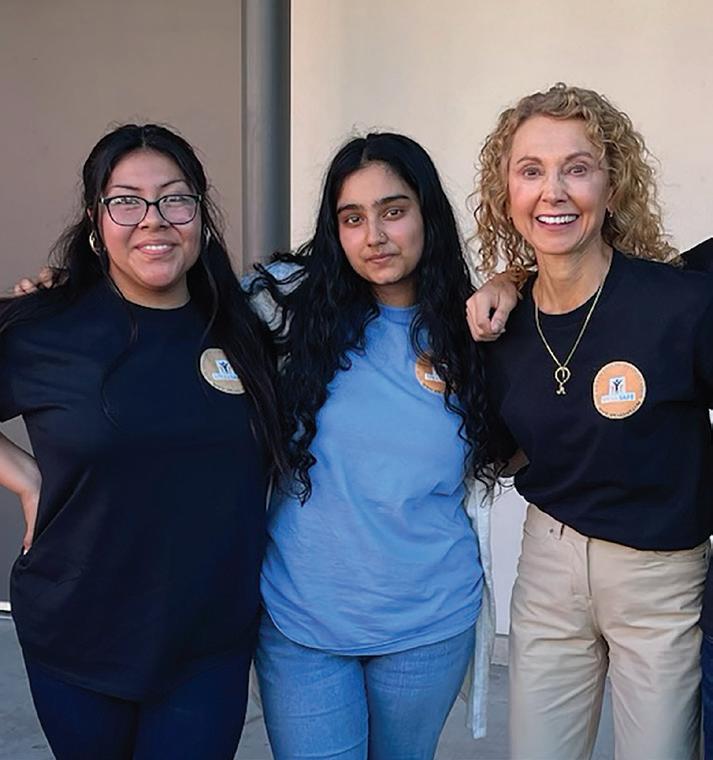
“I feel that as a youth, in regard
to youth exploitation, I can be more useful when it comes to the things that we do here at Speak Safe. Having people around me that are my age feels more collaborative,” Millstein said.
Capra had introduced the team to an application called “Take It Down” which, upon request, removes every possible picture of a youth that puts them at risk. Using these connections, Millstein successfully erased her friends’ leaked photos from the internet.
“Recently, a friend of mine had their pictures leaked by a scammer who threatened them for money. They posted [the pictures] on social media and tagged everyone from my school. I told my friend about Speak Safe, connected them with Marlene and got the pictures taken down,” Millstein said.
Page 18
bark@redwoodbark.org
YOUTH MEMBERS RITA Yam and Monica Kaur stand alongside Capra at their information table at San Rafael High School.
Photo courtesy of Marlene Capra
IN A SELF portrait, Jade Holmes displays her artistic focus, acrylic painting. She posts her most recent works on Instagram @jadeholmesarts.
Image courtesy of Jade Holmes hherbst@redwoodbark.org
CAPRA LISTENS TO the members’ input attentively as they share their “highs and lows” of the week.
Photo by Ava Carlson
Meet the new administrators for the 2023-24 school year
Assistant Principal Dean of Student Success
By Jay Knopping
Over the summer, Redwood hired a new assistant principal and dean of student success to its administration. Karen Hatton, the new assistant principal, worked at Tamalpais High School (Tam) as an assistant principal for the last four years before moving to Redwood.
“I have been in education for 25
years. I started in Napa as a middle school teacher, then I worked at Napa High School, then at Tam, and now I’m an assistant principal here at Redwood. I’m new to Redwood, but not to the job,” Hatton said.
Hatton’s job consists primarily of offering support to student services programs, including the special education department, wellness department, counseling department, academic workshop classes, peer resource program and the Tobacco Use and Prevention Education program. She supports students whose last names start with A through Gi. Hatton hopes to elevate the student voice with her new role.
“How are we creating opportunities to have regular input from student voices to inform our work? [We need] more student panels to see how we [can] integrate students into some of our professional development days for teachers,” Hatton said.
While Hatton has only been here for a few weeks, she’s already looking at changes designed to help support students. She has observed that because Redwood has so many feeder schools, friend groups can be very cliquey and she hopes to change that.
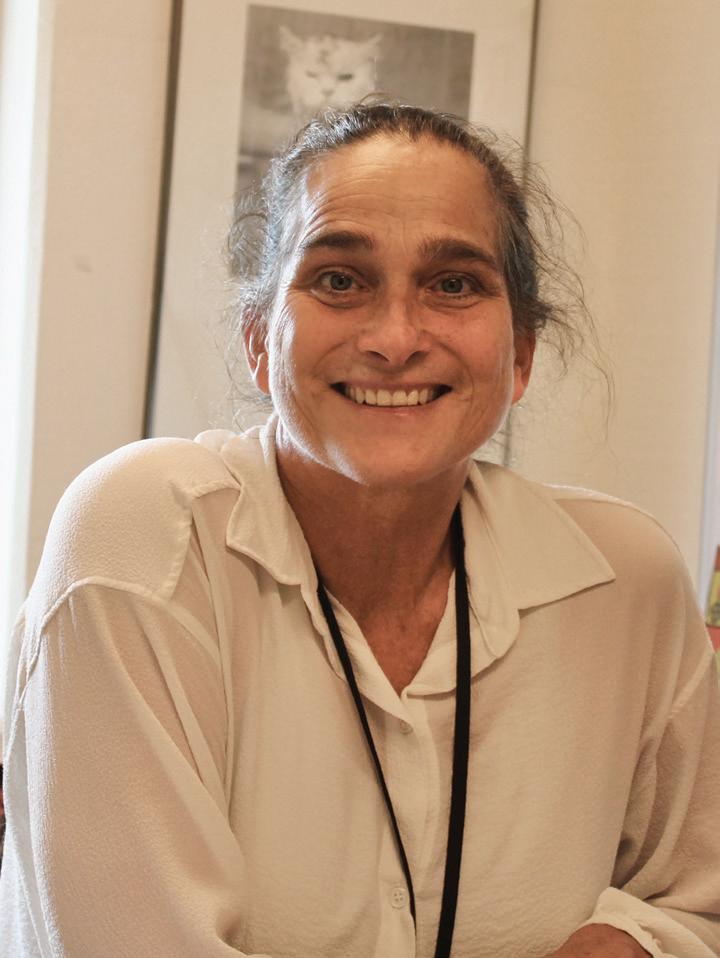
“[Maybe] a grade-wide lunch with provided food and fun games, like spike ball and music, [could] make everyone feel included,” Hatton said.
By Jay Knopping
The New Dean of Student Success Tyrone Robinson Jr. worked at Tam last year as a counselor. He previously has worked at Lincoln Middle School, Alameda High School, Berkeley High School and Encinal High School.

“As the Dean of student success, I’m here to dake sure [students] are successful. That includes student
attendance, making sure they show up and get to class on time [and] low-level discipline,” Robinson said. “I mainly just build student relationships to have a positive rapport with [them] and [their] families, so I can help [them] be successful.”
One way Robinson hopes to help students is by ensuring they feel like they have someone rooting for them and there to support them. He wants to make sure school is a safe environment.
“I hear a lot of students [say], ‘Oh, that teacher [or] that person just hates me.’ I don’t think anyone hates you here. Tyrone Robinson Jr. for sure doesn’t hate you,” Robinson said. Robinson stresses the importance of students’ feelings being supported at school.
“I don’t get joy in suspending anybody, or referring anyone to suspension. But what gives me joy is helping [students] through those situations,” Robinson said. “It is key for students to have someone to talk to and help them, and I’m happy to support them no matter what.”
“I’m looking forward to continuous improvement and learning; really, life is an adventure. Even bad experiences, for me, are good experiences because I’ll learn something out of [them],” Robinson said.
jknopping@redwoodbark.org
Chip Boaz brings a new tune with district experience
By Isabella Wagner
“I really love sharing music with young people, and I find it inspiring to see those that grow from that connection happening. I feel like music is really about people, and making that connection is important to me,” said Chip Boaz, the new music director at Redwood.

Boaz is an accomplished musician as well as an experienced high school teacher who has taken over the music director position John Mattern retired from last year. He teaches all sections of the music program, including Intermediate Performance Workshop (IPW), Advanced Performance Workshop (APW), Concert Band, Symphonic Band and Jazz Band. Boaz’s background in music and teaching has set him up for success in this role. His love for music all stems from his first interest in guitar.
“I grew up in a family that was not really musically inclined, but when I was a teenager, [music] was the height of MTV, and it was the middle of the 80s and I really wanted to play guitar,” Boaz said.
Around the age of 15, Boaz started on his music journey. From playing guitar at school, he discovered his passion for jazz, as well as a community centered around
“THE MUSIC COMMUNITY has been great and the students are really awesome. They’re in here playing all the time, they love music, they’re kind and like a little family, ” Boaz said.
music, and never turned back. This devotion to music transformed into a career and Boaz became an active performer as a bass player.
“Over the years as I've made my living as a performer, I’ve played everything from jazz, to classical, to rock, to salsa, to reggae and country,” Boaz said. “I have a jazz trio that plays all over Sonoma County. [We play] mostly original jazz that I write,
along with some standards and whatnot.”
Boaz plays bass for his trio, performing about once a week to several times a month. In addition to these performances, Boaz posts content online through social media, where he uploads clips of his live gigs and selfproduced music.
“I have a studio where I record music and create videos, and usually I post a full song about once a week on YouTube. On Instagram, Facebook, TikTok and all the other [platforms], I [post] usually shorter clips anywhere between four and six days a week, just to get the message out there,” Boaz said.
While performing is a strong suit for Boaz, he also loves sharing music with young people. Since his early twenties, he has taught private music lessons for students. Boaz then began his teaching career at Archie Williams High School, where he worked as the music director for 23 years prior to this
year, when he transferred to Redwood.
“I feel like there's a really strong foundation here and some really strong programs, so I'm not looking to completely change everything, but I'm hoping that I can bring some of my expertise as a performer [to Redwood],” Boaz said. “I can bring kindness and connection to human beings, and a passion for music and musical excellence.”
Junior Ally Woodruff, a student of Boaz, is currently enrolled in APW as well as the Jazz Band, and has been involved in the music department since she was a freshman. She recognizes the valuable qualities Boaz brings to the department.
“He's really enthusiastic, which definitely adds a lot. It was the first day, and I was a little nervous because he's a lot more high-energy than Mr. Mattern was, and I was like, ‘Oh, my gosh, this is intense.’ But I think [his teaching style] really shows his love for music, and it definitely makes me more passionate about the class,” Woodruff said.
Along with his enthusiasm, Woodruff reflects on the positive interactions she has had with Boaz so far in the school year.
“He's super encouraging. I had my first jazz mini-performance last Wednesday and I was nervous. It's my first year in jazz, and I've never sung jazz before, so I was scared, and [Boaz] was just like, ‘You got this, you can do it,’” Woodruff said. “Afterward, he made sure to come up to me and tell me that I did really well. He always seems to take the extra time or the extra step in connecting with his students, and making them feel good about the work that they've produced.”
iwagner@redwoodbark.org
bark www.redwoodbark.org Page 19 • Lifestyles
Photo by Harrison Lapic
“I’M DEAN OF student success and it speaks to who I am, who I want to be and why I got into education. I’m here to support students,” Robinson said.
“ONE OF MY favorite things is being at the front of the lunch line everyday and welcoming kids; all the students have been so respectful,” Hatton said.
Photo by Jay Knopping
Photo by Jay Knopping
I grew up in a family that was not really musically inclined, but when I was a teenager, [music] was the height of MTV, and it was the middle of the 80s and I really wanted to play guitar.
Chip Boaz, Music Director
Sam Warren writes his way to ESPN
By Jordan Kimball
Just four years ago, the class of 2019 threw their caps into the air in celebration of their high school graduation. It was a momentous achievement for all of these students who had worked so incredibly hard to receive their diplomas. Some say that their childhood is over when they graduate from high school, but for Redwood alum Sam Warren, when his cap was thrown, his childhood dream had just begun.
football and baseball player for Redwood and had a strong passion for sports. His football coach, Allen Talley, loved his dedication to the game and his desire to win.
He came out every day and worked hard with his [teammates]. He was extremely coachable and a great guy to have on our side of the ball,” Talley said.
Warren’s original dream was to play in either the National Football League or Major League Baseball, and he worked every day to accomplish that goal.
years at Redwood, Warren was a star, but the recruitment process prevented him from achieving those goals of playing in these professional leagues in the future. This led Warren to look for other ways to pursue his dreams. Fortunately, Warren found other passions in his life, his favorite being writing.
Warren began his sophomore year taking the Nonfiction course and was a part of the Bark staff in his junior and senior years. He enjoyed writing about sports and as graduation approached, Warren decided that he would pursue journalism in college.
After graduating, Warren attended Syracuse University, where he majored in Newspaper and Online Journalism while also getting to walk on and compete as a wide receiver on the school’s football team.

“Everything was going my way. I was playing football in the fall and writing about [Syracuse] sports during the [offseason],” Warren said.
As Warren spent more time at Syracuse, he took advantage of many opportunities that came his way. He wrote for the Syracuse student newspaper, The Daily Orange, and got the chance to write for Perfect Game USA and KGO-TV, a television station owned by the American Broadcasting Company, in his summers.
“Working with these [wellrespected] media companies was amazing for me to get some professional experience. I made many connections, which could also help me with my future jobs,” Warren said.

As time continued, Warren began building a name for himself in the Syracuse area. During the spring of his senior year, he served as a reporter for the Syracuse Mets, the New York Mets triple-A affiliate. He loved this position as it was a great chance for him to get started reporting within professional sports.
Finally, college graduation approached and Warren secured a summer sports intern job with the San Francisco Chronicle,
fulfilling a lifelong aspiration of his to report for the teams that he grew up rooting for.
“When I got this [position], I felt like my hard work had paid off. Starting to write for the Chronicle really made it feel surreal,” Warren said. “I got to attend Bay Area sporting events as a press reporter, something I had always wanted to do.”
Warren has now completed his summer working for the Chronicle and learned many important lessons and experiences to help him fully develop his sports media career. He plans to move to Connecticut within the next few weeks to begin his full-time job as a behind-the-scenes production assistant with the Entertainment and Sports Programming Network (ESPN) Next program.
“Working for ESPN [after] growing up watching them has always been a [target] for me. To receive the opportunity to work for them was something that I couldn’t pass up,” Warren said.
As Warren continues his profession in the sports media industry, he gives credit back to where it all started.
“In high school, I was able to really begin my career. I learned important skills that have put me ahead at every level,” Warren said. “If it weren’t for Redwood, I don’t think I would be where I am now.
jkimball@redwoodbark.org
View Warren’s articles here.
Photo courtesy of Syracuse football










































 By Erica Block
By Erica Block









 By Lauren Poulin
By Lauren Poulin



 Por Tallulah Knill Allen, Simon Leonard, Ian Krumwiede y Matthew Knauer
Por Tallulah Knill Allen, Simon Leonard, Ian Krumwiede y Matthew Knauer









 Story and Illustration By Lauren Olsen
Story and Illustration By Lauren Olsen






 By Beckett Tudor
By Beckett Tudor








 By Ashlin Quach
By Ashlin Quach




 By Emily Garcia
By Emily Garcia








